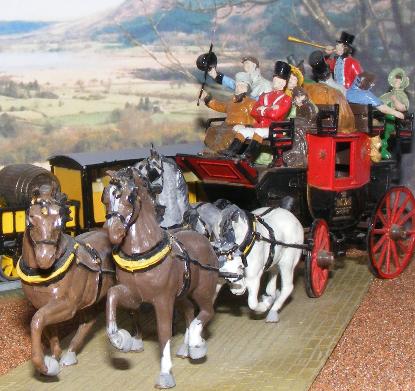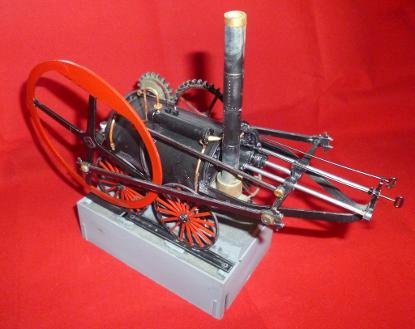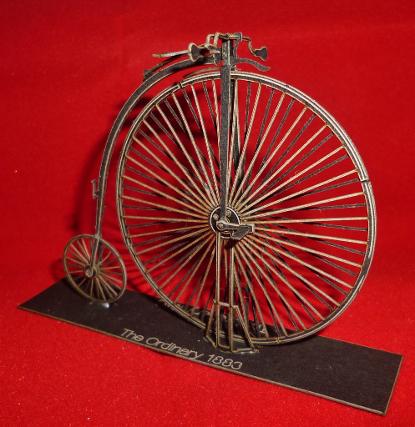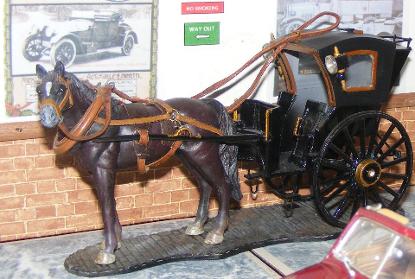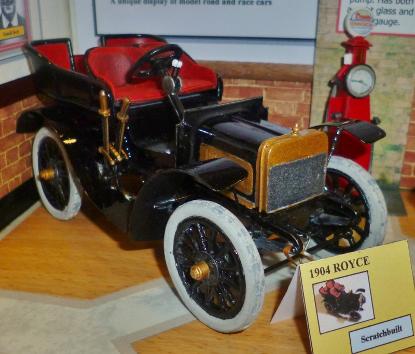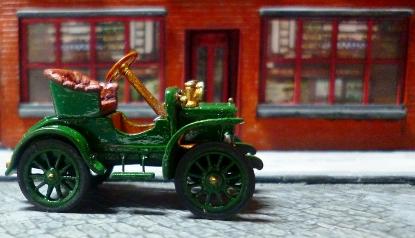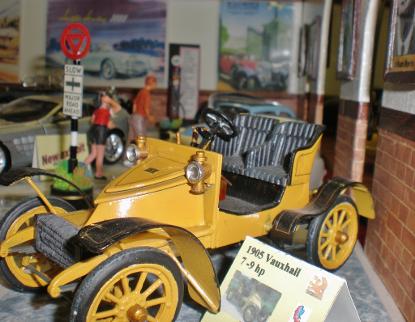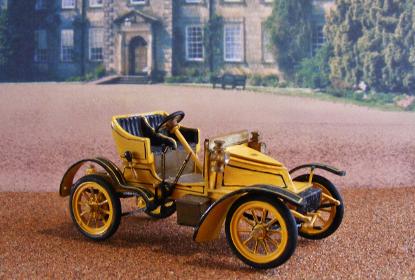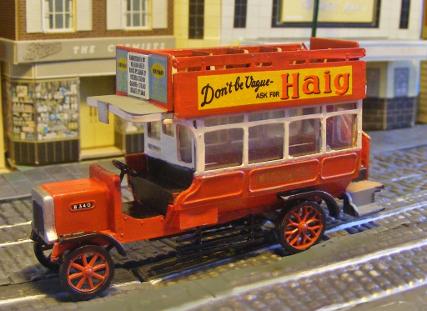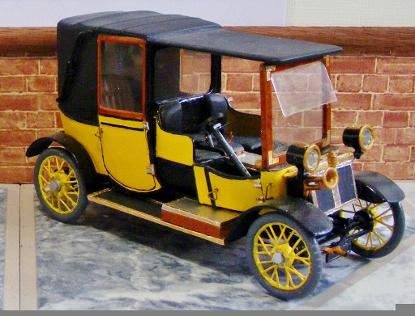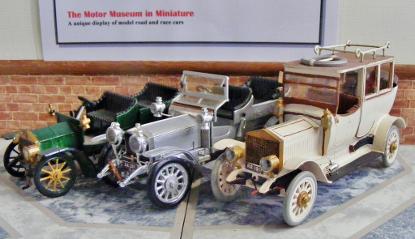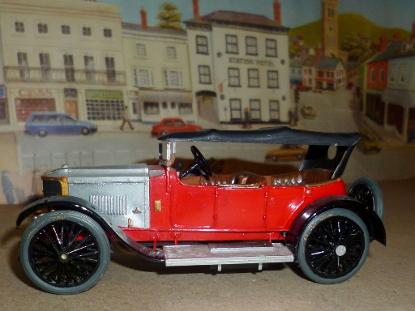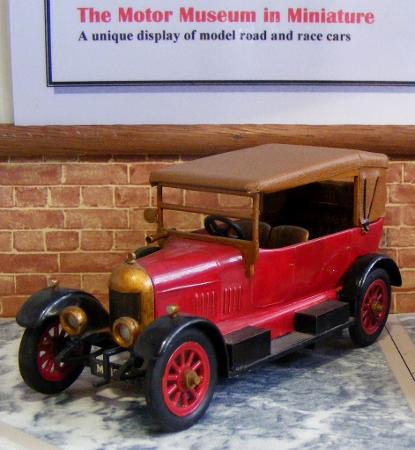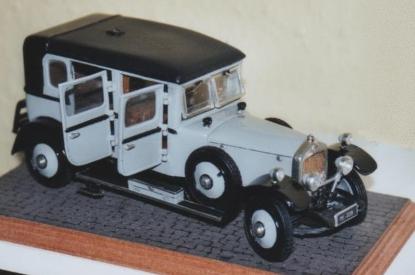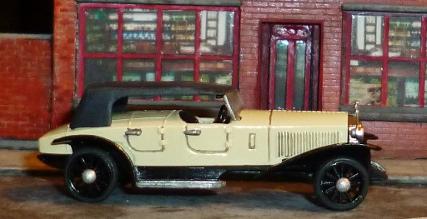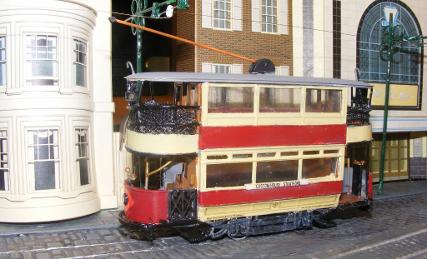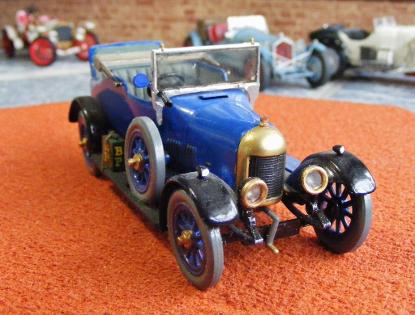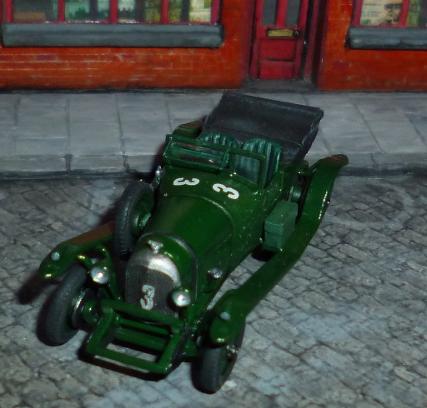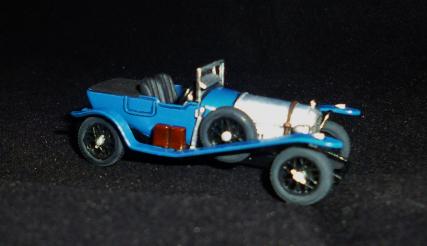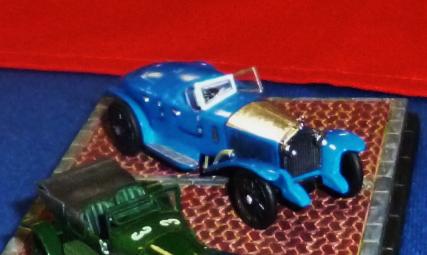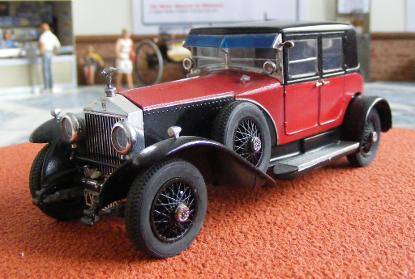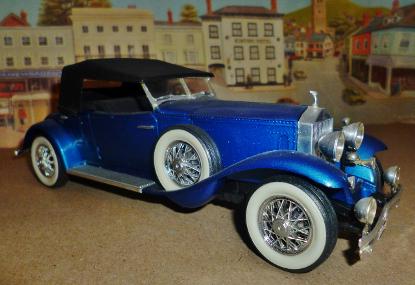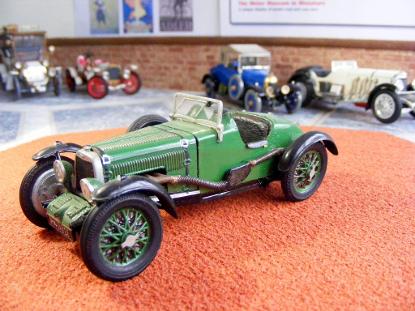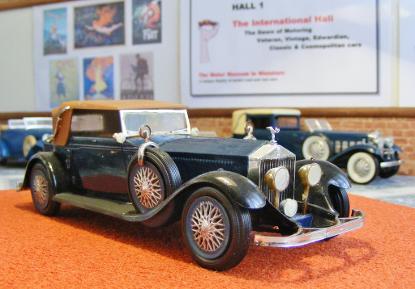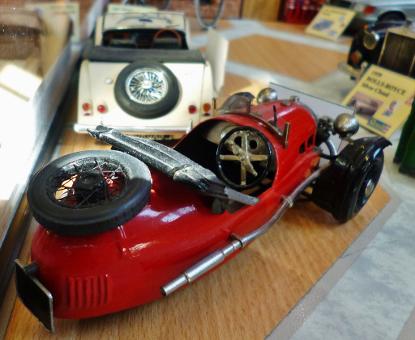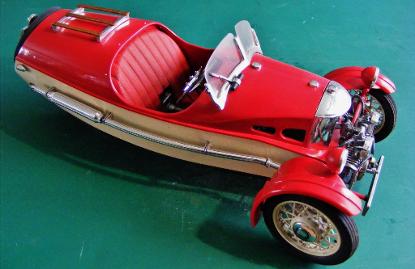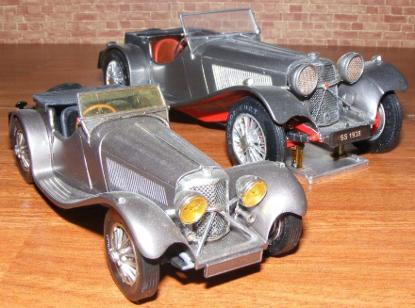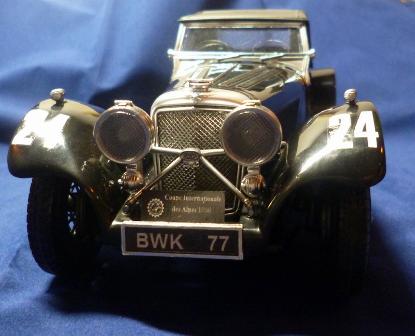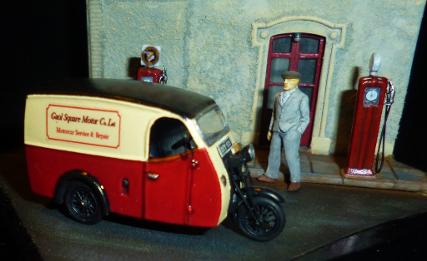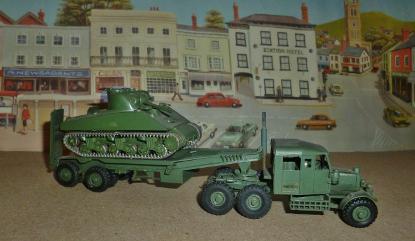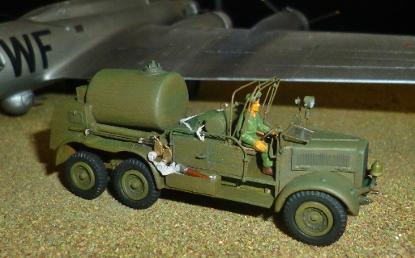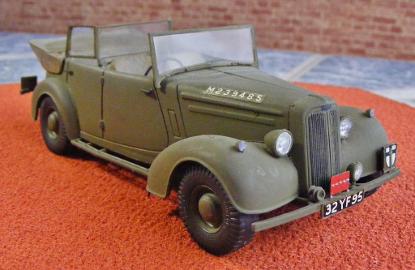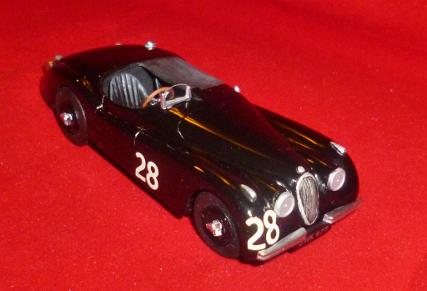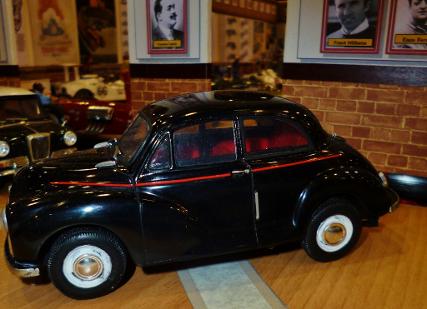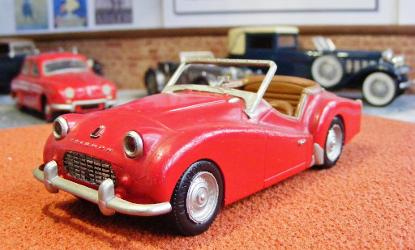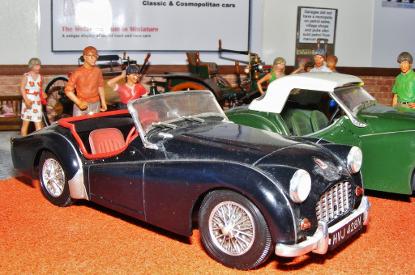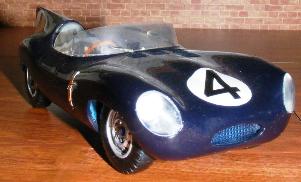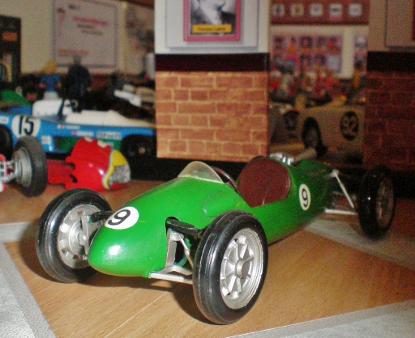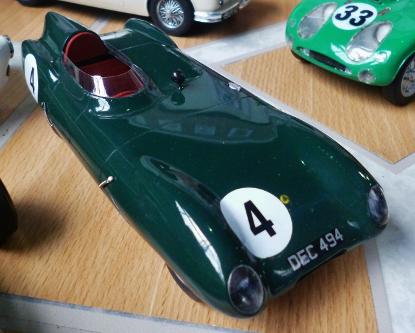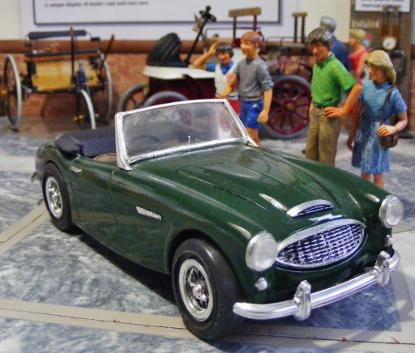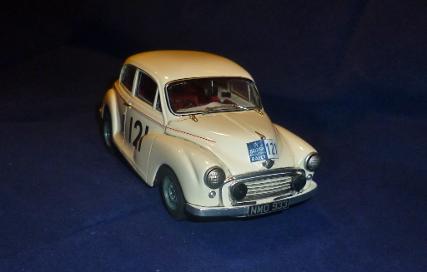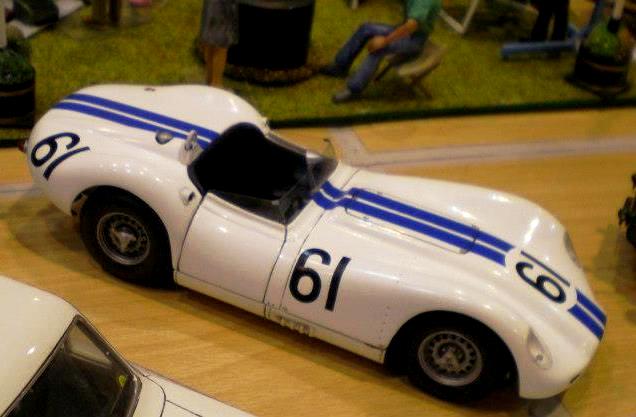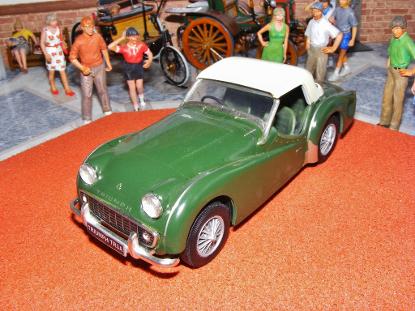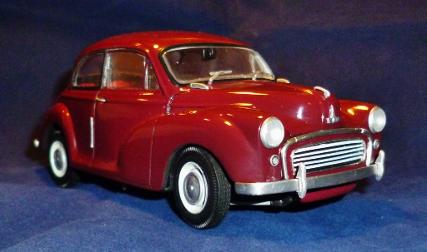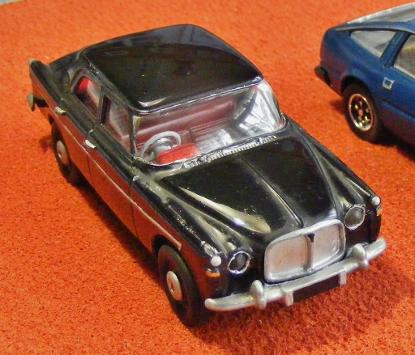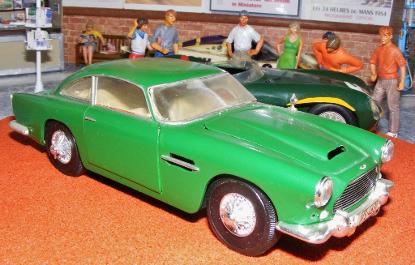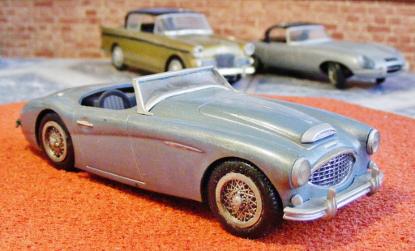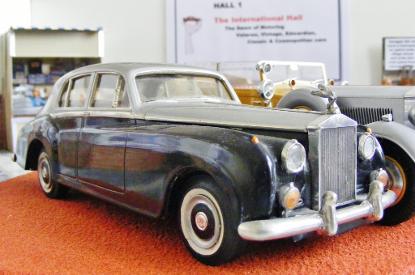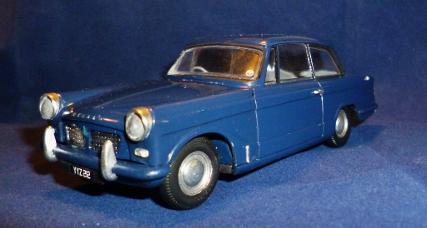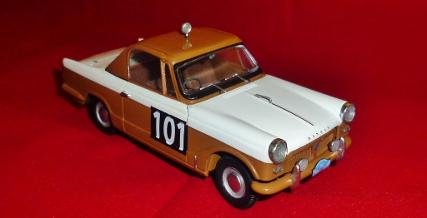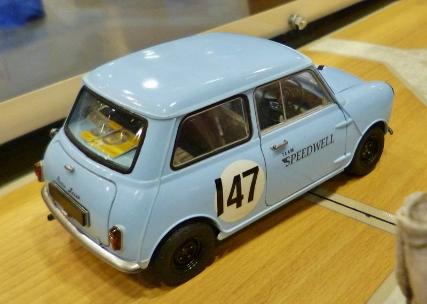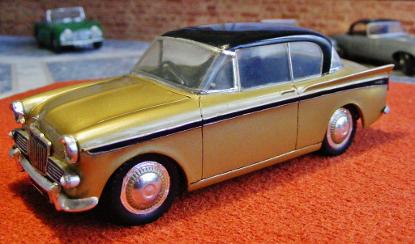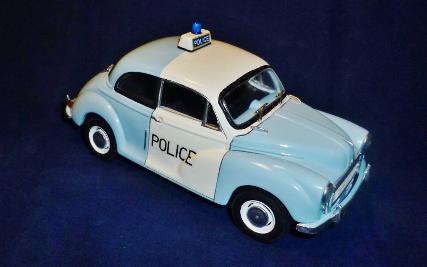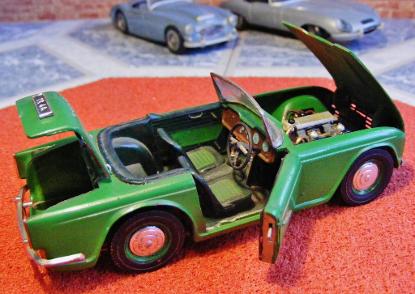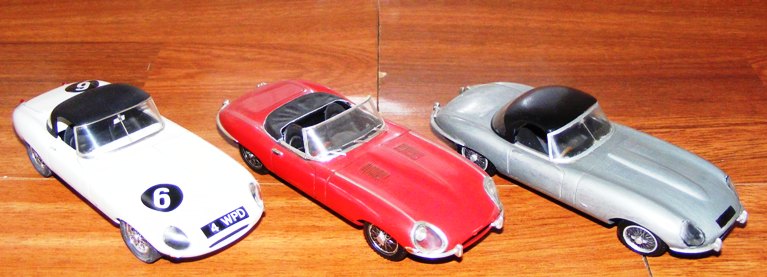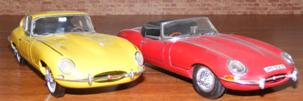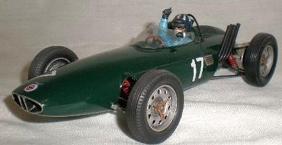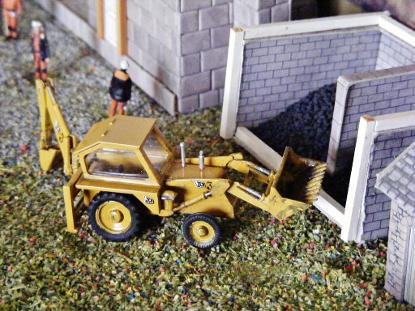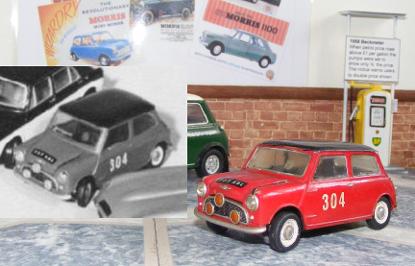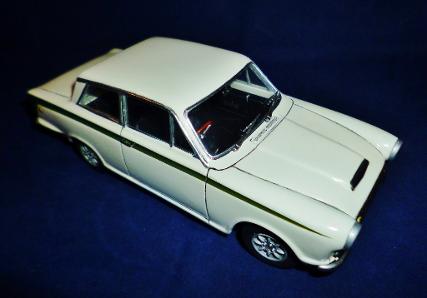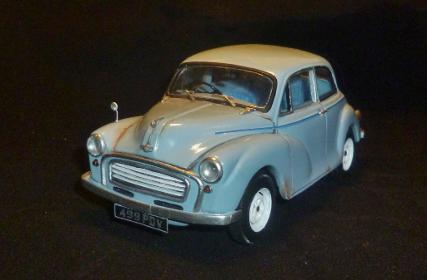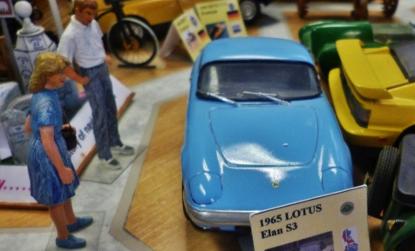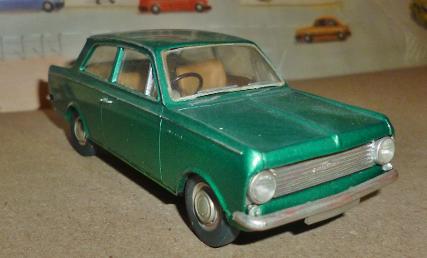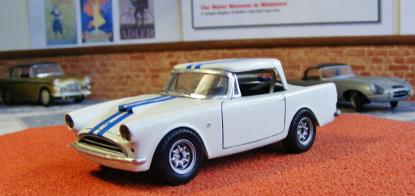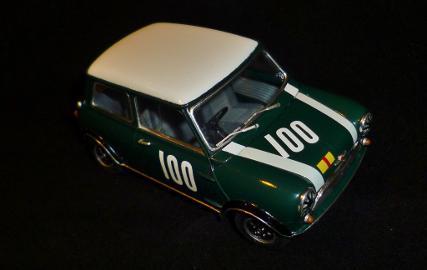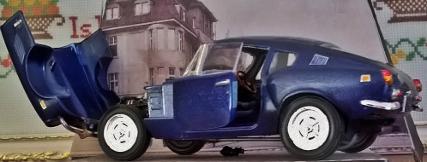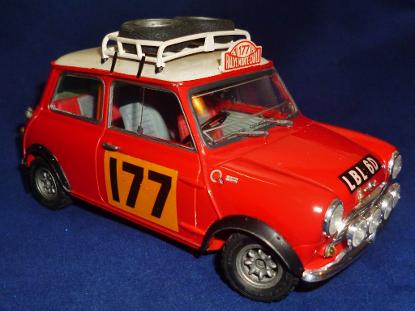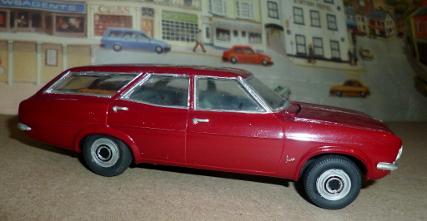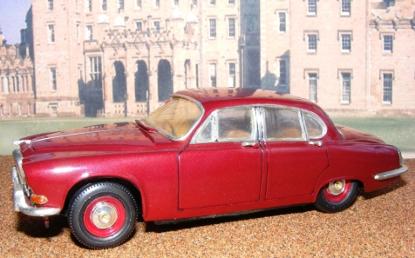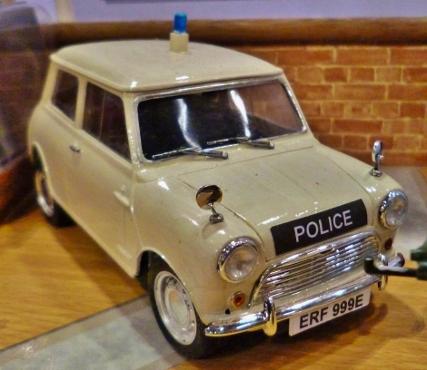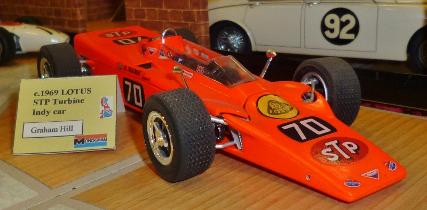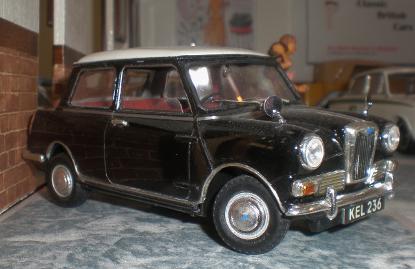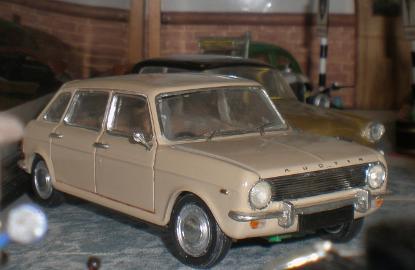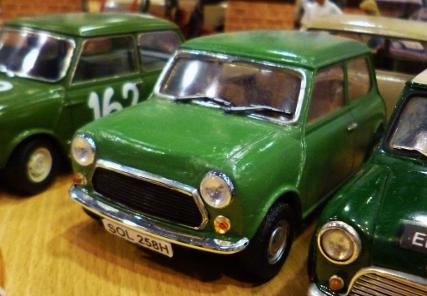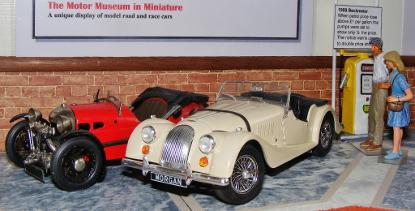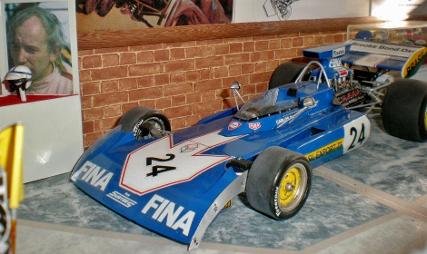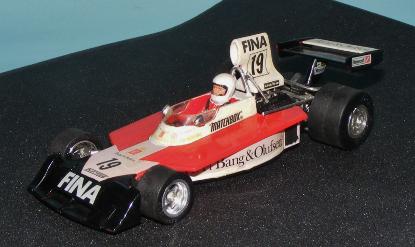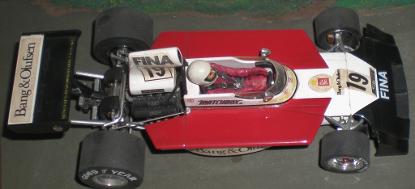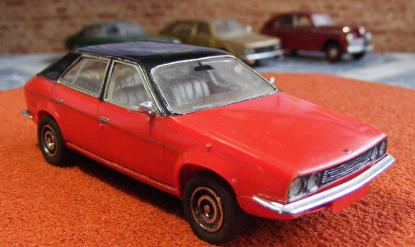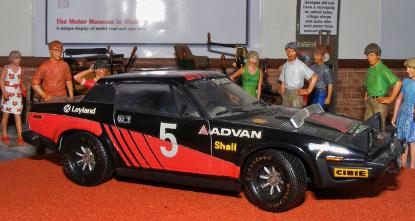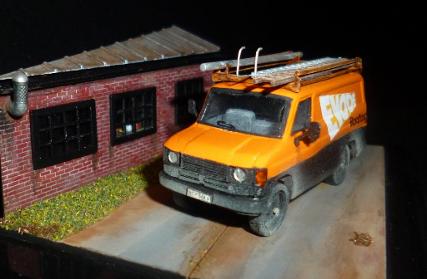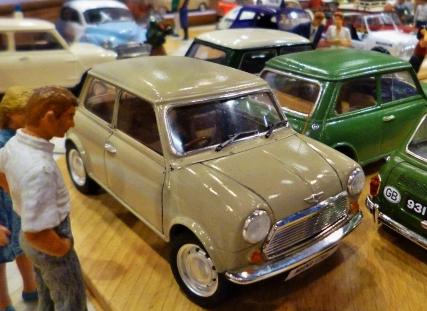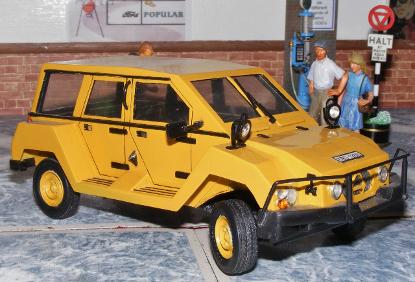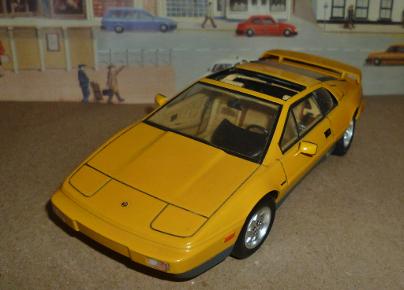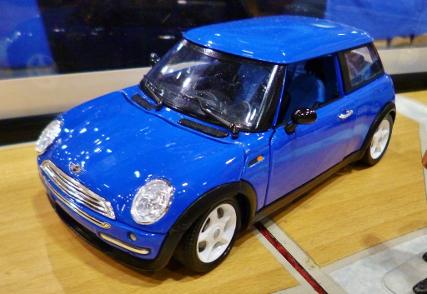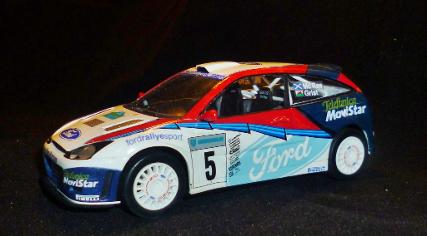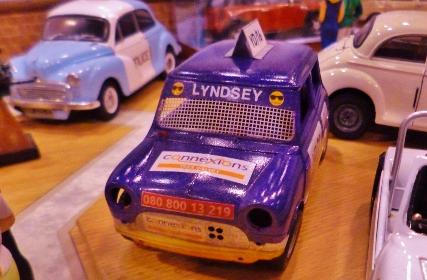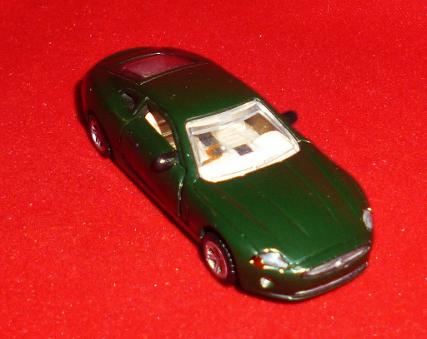The British Collection.
Britain was a hot bed of locomotive innovation and design in the early 1800s, people like Hancock,Trevithick and Gurney all had successes in steam road transport. As is often the case in Britain political pressures stumped all this progress and for around 80 years Britain languished in the automotive dark ages allowing other nations to profit from the British innovations. Germany and France forged ahead with Italy following closely while in Britain road going automotive traffic was kept at a walking pace, literally. The removal of the "red flag acts" (or more properly the repealing of the road Locomotive acts) in 1896 finally allowed Britain to start catching up in the field of automobile design and technology. In due course British cars and designs would go all around the world, break new ground in design and technology, break records galore in all manor of classifications, have the World's first purpose built racing circuit and, after some very trying times, become the leading nation in racing car design and manufacture.
Through this page we will show you much of this story, the highs and the lows, the rise and the decline of the British motor industry as well as some of Britain's influence on motor racing to.
This page is under construction and not all the model photo's link up to a main page yet. We are sorry for any disappointment but please keep popping back to see us as the page will evolve over the coming months.
1800 Besant design Passenger/Mail coach.
1/40th scale Life-Like kit
Early passenger coaches were rather poorly built, slow and often dangerous. In 1787 the controller general of the General Post office entered into an agreement to use Besant's improved and patented design.
In 1792 John Besant designed a coach that featured “band” braking, an improved turning circle and a device to stop the wheels from coming off. He bettered this design in 1795 and Besant and his business partner John Vidler not only had the exclusive deal to provide carriages but, by dint of an advisement of GPO controller general John Palmer, nearly all the servicing was done by Vidler & co too.
1803 Coalbrookdale locomotive.
1/32nd scale Airfix kit
The first locomotive to run on rails was the Trevithick steam engine he built for the mine at Coalbrookdale in Shropshire. One of the main achievements was to prove that smooth wheels on smooth rails would have enough friction to provide traction.
Whatever the shortcomings of the recreations, or the kit, the fact remains that the locomotive itself was a landmark vehicle.
1829 Stevenson’s rocket.
Ho scale Airfix kit.
Built in Newcastle upon Tyne, at the works of Robert Stephenson & Co., the basic design ideology came from the great George Stephenson. He was assisted by his son, Robert, (who was in daily charge of designing and constructing new locomotives while his father, George, was actually living Liverpool at the time of Rockets construction) and by an associate engineer Mr. Henry Booth.
The Rocket was not the first steam locomotive but it was the first to bring together the most advanced innovative ideas of the day which in turn made it the template for most steam locomotive designs, a design standard that lasted for a hundred and fifty years of steam locomotion.
1833 Hancock's steam coach "Enterprise".
1/24th scale scratch built model.
In 1833 Hancock's steam omnibus, the "Enterprise" (built for the London and Paddington Steam Carriage Company) began a regular service between London Wall and Paddington via Islington. It was the first regular steam carriage service, and was the first mechanically propelled vehicle specially designed for bus work to be operated.
1883 Singer Ordinary bicycle.
1/24th scale Aerobase kit
The penny-farthing encompases all the design and technology advances of the 1800s. Improvements in metallurgy allowed a strong light frame to be made from hollow steel tubing. Tensioned spoke wheels were invented by Frenchman Eugene Meyer in 1869. Ball bearings made rotating unions smoother, rubber pedals gave more grip and solid rubber tyres cushioned the ride far more than metal rimmed wheels.
Suddenly bicycles were lighter and smoother to ride than ever before and these design/invention steps would directly come to bare in Benz first three wheeled car.
As with many things that came out of the industrial revolution Britain made significant advances in the designs of bicycles. In Coventry the British cycle industry spawned Rover who would set the standard pattern for bicycles as we know them today.
1890 Fordor Hansom cab (Chapman design).
1/24th scale scratch built model
Joseph Aloysius Hansom’s cab of 1833 was unlike the vehicle that made his name a household word. Huge 7’ 6” (2.3m) diameter wheels made the absence of springs relatively unobjectionable!
Due to the publicity given to the Hansom patent later cabs were still called by Hansoms name instead of their designer’s name.
Edward Bulnois modified the Hansom using smaller wheels on a cranked axle. A better cab was patented by John Chapman but his company was bought out by the owners of the original Hansom cab patent. Chapman’s cabs were in all essentials the ‘hansom’ cabs which survived for the next 70 years.
Actual automobile production in Britain probably owes most to Frederick Simms. Now I'm sure you are all saying "oh yes, of course, Frederick Simms; I know all about him" but the truth is (to the casual motorist) his name means nothing at all.
Simms was the man who coined the terms "motor car" and "petrol", helped set up the Royal Automobile Club, and the Society of Motor Manufacturers and Traders. But most importantly he purchased the rights, in 1897, to build Daimler cars in Britain, and in setting up the Daimler UK company, and buying an old cotton mill in Coventry, established the country's first motor car manufacturing company and made Coventry the centre of motor car manufacturing.
In not naming his cars or company after himself Simms has slipped out of the collective motoring psyche, but he should not be forgotten. His venture led to being 53 automotive related companies in Britain by the turn of the century and 211 by 1905. In fact by then Britain was ranked third in the world for the size of it's automotive industry; behind only the United States and France.
Simms and his followers would still have found it impossible to succeed in their ventures if it were not for the change in the Locomotives on highways act in 1896. The major change was that cars were classified as light locomotives weighing less than 3 tonnes which raised speed limits to 14 mph although many local councils decided to cap the speed limit at just 12 mph. The red flag man was gone and the motorist had a new freedom to travel at a speed that would foster the fledgling motor car industry. Britain was finally free to compete with European countries on an equal footing, little wonder the motorists gathered for that first Emancipation run from London to Brighton.
1904 Royce 2cyl.
1/24th scale scratchbuilt model
Sir Henry Royce was fascinated by all things mechanical. His company made electrical equipment and cranes but he became increasingly focused on motor cars and began considering the motor car as a potential new product for the company.
Royce bought a small De Dion first, in 1901, followed by a 1901 model two cylinder Decauville around 1902/3 a. This car did not meet his high standards and so he first improved it and then decided to manufacture a car of his own, which he did in a corner of his Manchester workshop in 1904. Our model replicates that car.
Two more cars were made and one was sold to one of the Royce Co'. directors, Henry Edmunds. Edmunds was a friend of Charles Rolls who had a car showroom in London selling imported models and showed him his car and arranged the historic meeting between Rolls and Royce at the Midland Hotel, Manchester, on 4 May 1904.
1905 Rover 6hp.
1/76th scale Scale Link kit
Rover set the world standard for bicycle design in 1885 and the Rover name actually became the word for bicycle in several eastern European countries.
Like many cycle manufacturers Rover diversified into motor bikes and eventually cars. The 1904 Rover 8 was also a world first in that it had a backbone chassis, an idea used by the great Colin Chapman some 65 years later.
In 1905 Rover made a smaller lighter, cheaper car the 6hp, and also their first 4 cylinder engined car, clearly the company was expecting great things in their automotive ventures.
1905 Vauxhall motor cab.
1/24th scale scratch built model
One of the oddest motor cab designs of the early 20th century came from Vauxhall. Basically a Hansom cab sat on a 1904 Vauxhall motor chassis it has the driver's seat and the driving controls outrigged at the rear of the roof. One shudders at the thought of how many corners and linkages the controls had to go through before performing their function!
1905 Vauxhall 7-9 hp.
1/24th scale scratch built model
1/32nd scale Airfix kit conversion (lower pictures)
Alexander Wilson set up as a maker of small marine engines & pumps on South bank of the Thames near Vauxhall Iron Works. He adopted as the company crest, a Wyvern, of Fulk le Brent, a successful soldier of fortune in the time of King John, who had lived close to Wilsons factory site.
At the 1905 Motor Show Vauxhall exhibited the 3-cyl, 7-9hp model at £375 including lamps and all accessories - these were rarely included in the price by other makers. Also in 1905 finding expansion impossible Vauxhall moved to Luton. By a fantastic coincidence, Luton was the original home of Fulk le Brent! So the Wyvern was still appropriate. Another event of paramount importance was the addition to the staff of Lawrence Pomeroy Snr.
If Vauxhall 3cyl cars had been a little dull in performance terms Pomeroy's work in engine breathing, which began with the 1908 L head monoblock 3ltr side valve engine, would eventually give Vauxhall the first real British sports car, a record breaking run up Shelsley Walsh hill climb and bring Britain's motor industry respect through Vauxhalls performance in the international "Prince Henry" trials.
1905 Rolls-Royce 20hp.
1/32nd scale Airfix kit
After the famous lunch at the Midland hotel Rolls and Royce started their partnership and gave the world one of the most famous car marques ever. If Rolls and Royce are well remembered the real architect of the firm's success was Claude Johnson, later known as "the hyphen in Rolls-Royce".
While Rolls lost interest in cars in favour of the next exciting development, aircraft, (which ultimately cost him his life) and Royce slowly succumbed to ill health, it was Johnson who took over the running of the company and saved it from collapse.
In time Rolls-Royce would become the pinnacle of motor car engineering but the motoring side of the company was almost always on a financial knife edge.
1906 Rolls-Royce "Light Twenty".
1/32nd scale Airfix kit conversion
Rolls Royce are not well known for racing but Percy Northy drove a "light 20" to came second in the 1905 Isle of Man Tourist Trophy race in 1905. In 1906 Charles rolls returned and won that I.o.M. tourist trophy for Rolls-Royce.
The 1/32nd scale model is a conversion of the Airfix 1906 RR kit. Note the change to wire spoked wheels.
1907 Lanchester.
1/32nd scale Airfix kit
F.W. Lanchester is considered one of the most brilliant brains ever applied to the motor car. He didn't follow convention but started back at the basics and rethought each element to eventually produce motor cars which were designed well ahead of their time, engineered to Rolls-Royce like standards and almost as refined.
A 4-cyl. 2460cc engine with horizontal valves closed by leaf springs. Wick carburettor with no jets. Flywheel Magneto. Self adjusting multi-plate clutch in oil bath. Disc brakes. Fully automatic lubrication. Transmission by 3 speed epicyclic gears transmitting power to a drive in back axle. (Both features years ahead of their time.) suffering a little by having tiller steering it could still reach a top speed of 50 mph.
When F.W. started to pass car design to his brother George there was no reduction in the standards or ingenuity of Lanchester cars. George Lanchester was almost as brilliant as F.W..
1907 Rolls-Royce 40/50.
1/24th scale Airfix kit conversion
Henry Royce was an engineer making electric cranes in Manchester. In 1904 he purchased a French 2-cyl. Decauville car, although not the worst of cars of the day, Royce was not satisfied with its mechanical crudity, so set to work to build himself a 2-cyl car of modest power, but great refinement, which soon went into production.
Charles Rolls was also a perfectionist. In the early days of motor racing he was a consistent competitor on Panhard and Mors cars. He also had a business for the sale of Panhard and other foreign cars. Rolls was delighted with the watch like precision of the little Royce car and the world famous partnership ensued. Rolls was killed in 1910 when his Wright aircraft crashed from only 6 feet off the ground. He had already lost interest in the Company that was saved only by the third partner, Claude Johnson, who gave it stability and direction.
The General’s motor bus operation began in 1905 and standardised on petrol engines and produced their own buses at Walthamstow from 1909. The most famous of their vehicles was the B-type of which 2,900 were built making General's fleet the world's first major standardised vehicle fleet.
1910 Lanchester Double Landaulette.
1/32nd scale Airfix kit conversion
In spite of their unorthodox appearance Frederick Lanchester's Birmingham built cars were well known for their advanced technology, high quality, and comfort. Styling was of secondary importance to Lanchester so the 3.5-litre, six-cylinder engine sits between the two front seats. Such cars were purchased by the upper class and even by royals who appreciated the quality and comfort as well as easily accepting the "carriage" styling they grown up with.
Lanchester actually produced very few models working rather on continual improvement of the existing vehicles. This policy was extended to taking in clients existing cars and upgrading them to the latest specification.
Our model represents a car that was originally bought by the owner of a coal mine but sadly ending its days in the hands of a garage owner who used it for taxiing and ferrying a local football team around. Fortunately it was restored and now resides in the Louwman Museum in the Netherlands.
1911 Rolls-Royce Limousine.
1/32nd scale Airfix kit
The "40/50" open tourers became famous after the "Silvers Ghosts" exploits and the name eventually spread to all the 40/50 range. The open drive Barker bodied car was the prefered chauffeur driven car keeping the class boundaries clearly in place.
Known simply as "the Best car in the World" 40/50hp "Silver Ghost" models were on sale from 1907 to 1926 when the "Phantom" range took over.
1911 B-type Motor Omnibus.
1/32nd scale Airfix kit
The London General was formed in 1856 by the purchase of several independent horse-bus concerns and the early steam and electric motor buses were based on the horse bus.
The General’s motor bus operation began in 1905 as did the Road Car Company with strong competition from the London Motor Omnibus Co. under the name ‘Vanguard’. The ‘General’ standardised on petrol and from 1909 produced their own buses at Walthamstow, the most famous being the B-type of which 2,900 were built becoming the worlds first major standardised fleet.
1911 Vauxhall "Prince Henry".
1/32nd scale Airfix kit.
In 1905 event Lawrence Pomeroy joined Vauxhall. He was to be instrumental in redesigning the company's engines. He convinced the company directors he could build a 3lt engine, with an output of between 23 & 40hp, without increasing it's size over the current model.
Pomeroy's study of gas flow and valve timing proved revolutionary, and not only in the crank shaft speed meaning. At the request of Vauxhall MD Percey Kinder Pomeroy began development of his ideas in 1908 with a view to entering a Vauxhall car in the British 2000 mile trials. His car took overall best performance.
These cars were later entered in the European classic "Prince Henry" trials and their performance, while not a danger to the bigger engined Austro-Daimler models, it astonished the Europeans and gained Britain new respect in the motoring world.
1913 Vauxhall 'Prince Henry'.
1/32nd scale Airfix kit conversion
Vauxhall’s ‘Prince Henry’ was one of the first sports cars to be catalogued by a British manufacturer. Development began in 1908 when L. H. Pomeroy convinced Vauxhall directors he could redesign the 3ltr engine from 23 to 40 hp with no increase in size. His study of gas flow and valve timing proved revolutionary, not only in the crank shaft speed meaning.
L. H. Pomeroy said “Power output is finally dependant upon weight of air efficiently burnt per minute, and this in the end is fixed absolutely by the breathing power of the valve gear. In detail the gas flow will depend on the area of the valves, the lift, and the time during which they are open.”
Later the 30/98 of 1920 also benefited from this engine technology.
1915 Dennis pump escape.
1/32nd scale Airfix kit
The Dennis chassis was used for a number of vehicle types, as was common at the time, but none is more evocative than the pump escape. With Zeppelin raids increasing London fire brigade needed the latest equipment, little did they know how much worse was to come just 25 years later.
1921 Vauxhall 30/98.
1/24th scale SouthEastern Finecast kit
Vauxhall's 30/98, or "E" type sports car went into production in 1919. It lent heavily on the lessons learned with the "Prince Henry" model and would become Britain's first true "sports" car.
Rated at 30bhp @ 1000rpm it could do 85mph and when stripped for racing would go past the 100mph mark. It's excellent performance was matched by road holding and handling characteristics which put it ahead of anything else then available to the public. Post war it remained ahead of the competition being improved in OE type.
The model set many records and was equally famous for breaking the Sydney to Melbourne and Brisbane to Sydney speed records, a feat achieved by the Australian importer, Boyd Edkins, in one of only thirteen 30/98s built before WWI.
1923 Morris Cowley.
1/32nd scale Airfix kit
William Morris set up a new company in 1912 when he moved on from bicycle manufacturing to making, repairing and servicing motor cars. From these quiet early days a giant of the British motor industry would grow. Morris also spawned the legendary MG sports car company.
Morris cars weren't particularly superior in their designs or performance but W.M. set up, and perfected, assembly lines that would allow him to build his cars more efficiently and pass on cost reduction to consumers.
The first Morris car, the Oxford, was built at Cowley and had White and Poppe 10hp 4-cyl engines. More than 1000 units were sold prior to WW1. The Cowley went on sale in 1915, largely built with British parts, and improvements were made regularly. Due to low costs and high production rate these cars are the British equivalent to the American Ford 'T'.
After WWI the rounded radiator shell that had given the car the nickname “Bullnose” now hid a 1495cc 11.9hp 4-cyl Hotchkiss engine. The car was surprisingly spritely and the engine was almost indestructable so it is not surprising that these little cars sold well. Thanks to it's speed and handling, these would form the basis of the MG sports cars in the 1920s.
1925 Lanchester Forty.
1/24th scale scratch built model
The ‘Forty’ 7-seat Limousine.
Lanchester's name had been in motoring since his first brilliant prototype car was built in 1895. Though he had little business success himself his commitment to quality and innovation meant his name remained and his brother George was able to salvage the company and keep it going.
This model replicates a car supplied to HRH the Duke of York (Later King George VI) and in which Queen Elizabeth II made her first public appearance at the age of six weeks.
Motor historians described the ‘Forty’ as a splendid old fashioned car; this misses the point as the only really old fashioned feature was its quality. There were few Edwardian engines of only 6¼ litres capable of propelling 2½ tons of lordly carriage at 78 mph.
1925 Bentley 3Ltr Weyman tourer.
1/32nd scale Airfix kit conversion
Bentley was probably the most outstanding marque of the 45 that were launched in Britain immediately after World War 1. Formed in 1919 Bentley Motors Ltd lasted only 12 years, suffering severe financial problems for most of them. Despite this, 3,034 top quality cars were built and ten major races fell to Bentleys, making the marque became legendary.
The first 3-litre Bentley was running in October 1919, with a 4-cylinder SOHC engine. A four-speed gearbox was set into a very sturdy chassis with semi-elliptic springing all round and friction shock absorbers. Braking was on the rear wheels only.
Rolls-Royce cars have always been the embodiment of quality. Nothing less than 100% perfection in every single part of their cars is acceptable; from the founding of the company to the present day. The cars of royalty, the ultimate status symbol, nothing has more prestige than owning a Rolls-Royce.
However, innovation and development are continuously evolving and even Henry Royce accepted this fact. Furthermore the customers whims and beliefs are just as important as any specification sheet. So, when Bentley cars started winning at Brooklands in 1921, and then at le Mans in 1924 too, it was clear Rolls-Royce needed a sportier image too.
In the late 1890s electrification started to become a real proposition and the days of the horse bus wer numbered. Interestingly, the battle between the electric tram and internal combustion engined bus would again be ongoing 100 years later.
1926 "Bullnose" Morris .
1/32nd scale Airfix kit
The Morris "Cowley" was so named for the place of production, had an engine which was really a Hotchkiss design with alterations designed by W.M. The car was surprisingly spritely and the engine was almost indestructable so it is not surprising that these little cars sold well. The later Oxford was merely a larger engined Cowley but the 6 cylinder "Bullnose" was the top of the range model which, thanks to it's speed and handling, would form the basis of the MG sports cars.
This body style became known as a "Doctor's runabout" due to the popularity with Doctors at the time who could have an affordable motor with a certain amount of flexibility in the seating arangements.
1926 Thornycroft "PB" 4 ton truck.
H0-00 scale Peco kit
Thornycroft listed their 4 ton ‘PB’ in October 1926. Especially designed for delivery work in towns, were space was restricted, it was designed with the cab virtually on top of the engine. This was termed the ‘forward-control’ chassis and allowed the ‘PB’ a bigger load area than the earlier ‘KB’ model despite being on the same wheelbase and almost the same overall.
1927 3-litre Bentley 'le Mans'.
1/87th scale R&L 'Jet Promo' kit super detailed
The production 3-Litre Bentley was tested and proved on the racing circuit and were every bit as good as anything else. In 1924 a privately entered 3-litre Bentley won the le Mans 24hr endurance Grand Prix and convinced the sceptical W.O. Bentley that it was a race worth competing in.
But try as they might, the Bentley works team had nothing but bad luck over the next few years. Even in 1927 they had to endure the infamous "White House Crash" which involved all of the three team cars eliminating two of them completely.
Unbelievably the battered 3-litre Bentley, tied up with string, held together and won the race.
1927 3-litre Bentley.
1/87th scale R&L 'Jet Promo' kit
The first of the new production 3 Litre Bentleys (production chassis No.1 and engine No.3), was delivered to one Noel van Raalte on the 15th of September 1921, looking pretty much as we expect to see them today; although the price of the Bentley 3 Litre rolling chassis had risen from the 1919 price of £750 to £1100 by late 1921, This car, like EXP2, is still dunning today!
Not really interested in developing a sports car, or in going racing, Royce was slightly disappointed in the 1925 New Phantom’s performance. It was a step up from the '40/50' Silver Ghost but the competition seized upon this weakness and Royce was concerned. The size and weight of some of the bodies being fitted to the chassis certainly didn’t help.
His response was the 'EX'perimental series which, he hoped, would see a Rolls-Royce touring car breaking the 100mph barrier.
1928 Rolls-Royce Phantom.
1/32nd scale Matchbox kit
The legendary Silver Ghost was followed in 1925 by the various Phantoms (I, II, III.). Although the Ghost was still available to special order.
This is a Model of the Phantom I supplied to Diamond Magnette Otto Oppenheimer on 1st May 1928. the headlamps were by Stephen Grebel with Barker patented dipping mechanisms. All interior and exterior fittings were silver plated with ivory fixtures to some.
Known as ‘The Black Diamond’ the car had a secret compartment for the safe transportation of Diamonds.
1929 Bentley 4.5 ltr tourer.
1/24th scale Union kit conversion
The 3Ltr was followed by the 4.5Ltr from 1927, later being supercharged from 1929. The 4.5Ltr model was available as a tourer, drophead coupé and 4 seat sports car, in total 720 vehicles were produced. Although not that outstanding in overall performance a 4.5Ltr did win the 1928 "le Mans".
The 4.5Ltr was a large and heavy car. It was 172 in long, had a spacious interior and weighed in at 3,580lb. The Weyman body is made from canvas stretched over a light wooden frame, this results in a texture and finish difference between the metal covers of the engine and the fabric body of the saloon area. This is a very light, but still wind and weather resistant, form of bodywork chosen by several British coachbuilders of the era.
1930 Bentley 4.5 ltr "Blower" le Mans.
1/24th scale Heller kit
1/32nd scale Airfix kit
Most famous of all the Bentleys was the 4½ Litre, in particular the supercharged 125 mph ‘Blower’. Although not the first make to supercharge their engines Bentley engineer Amherst Villiers was recognised as one of the best engine and supercharger designers.
W.O. Bentley himself was very unkind about the ‘Blower’ which was against all his engineering principles "….to supercharge a Bentley engine was to pervert its design and corrupt its performance….when we want higher performance, we increase the engine size…"
1931 Rolls-Royce Phantom II Henley roadster.
1/24th scale Monogram kit
Rolls-Royce America is inextricably intertwined with the Brewster & Co. Coachworks of Long Island, New York. Willie Brewster was the pre-eminent American coachbuilder at the turn of the 20th Century becoming a Rolls-Royce agent importing chassis from England and building bodies for his well-established and discerning clientele. Brewster's fitted some of the most attractively proportioned bodies on any Rolls-Royce chassis anywhere, being elegant and sporting these cars are now highly collectable.
1931 Aston Martin "le Mans".
1/32nd scale Pyro kit
Shortly before the first World War Lionel Martin, a competent competition driver, installed a Coventry Simplex side-valve engine into a small Isotta Fraschini chassis. This successful competition car was christened by Lionel Martin as the Aston Martin from the popular hill climb at Aston Clinton, near Aylesbury. Bamford & Martin was formed to build similar cars, but the war intervened until 1920 when production in small quantities began of a very refined and attractive (but expensive - £800) 1½ lt. side valve engine car capable of giving Bugatti a good run and frequently beating them in speed trials and hill climbs.
Unfortunately Bamford & Martin was not successful financially and in 1926 Renwick & Bertelli acquired the name for the production of a car to the specification of Augustus Bertelli. Although several hundred pounds cheaper it was altogether more advanced being capable of more than 80 h.p. at 5250 r.p.m.
1933 MG K3 Magnette.
1/32nd scale Airfix kit
Regarded as one of the greatest MG’s ever produced. The K3 can claim a deserved place in the history of British motor racing. In the early 30’s the International Racing scene was dominated by foreign cars (Bugatti’s, Maseratti’s and Alfa-Romeo’s). Cecil Kimber decided to attack the 1100cc International class G racing series with a new car, the MG K-series. The new "Magnette" 1100cc range was launched at theLondon Motor Show of October 1932 and sat nicely between the 847cc Midgets and the 1271cc Magnas.
The Range comprised the road going K1 (four-seater) andK2 (two-seater), as well as the sports racing K3.
1933 Rolls-Royce Sedanca Coupe.
1/32nd scale Pyro kit
The legendary Silver Ghost was followed in 1925 by the various Phantom series.
This, the last of the vintage Rolls Royce’s, was the first entirely new design in the large-car range since 1906. The manifolding was changed but otherwise the Phantom I engine layout and dimensions were retained. The Phantom II although heavy was a car of considerable performance with a maximum speed well over 80 m.p.h.
1934 Scammell Mechanical Horse.
1/72nd scale Airfix kit
The “Mechanical Horse” was introduced in the UK around 1934 to meet the railway companies need for a vehicle to replace horse drawn carriages. Several companies submitted designs but it was Scammell Lorries Mechanical Horse, designed by O.D North, that won through.
1934 English Electric Blackpool tram "Princess Alice".
H0-00 scale Hadfields kit
Known as “Princess Alice” was amongst 27 built by English Electric from 1934 to 1937. 13 of which were the open top variety.
The Blackpool tram was a holiday icon for Brits in the first half of the 20th century and many holiday memories included a trip on a tram. So much so that many of these trams are immortalised in kits and painstakingly restored by enthusiasts across the UK.
Trams in cities might not have had the glamorous appeal of the coastal holidays but they performed an indispensable task in keeping commuters moving; so indispensable that many UK cities are reintroducing trams in preference to running busses. Although their motivations may be prompted by the ecological advantages there are also social and psychological reasons behind the the return to trams.
1934 Morgan Super Sport "Beetle back".
1/24th scale Southeastern Finecast kit
Henry Frederick Stanley Morgan was 28 when, in 1908, he designed and built his first single seat three wheeler car. He could never have dreamed he would become one of the world's major three wheeler manufacturers and a luxury Marque desired the world over.
Morgan were constantly revising their designs and the spare wheel storage had always been a problem. Up to 1935 the spare was located on top of the rear deck "for ease of access". Reasonable, but eating into what little luggage space there was.
The Aerosport series were the last three wheel cars before Morgan moved into four wheeled cars.
1934 Rolls-Royce Phantom MKII.
1/24th scale Italeri Kit
The Phantom II had the 7668 cc pushrod OHV straight-6 engine as the preceding model and was the last large six-cylinder Rolls. The engine was mated to a 4-speed manual ‘box. This car replaced the New Phantom in 1930. Some of the most famous coachbuilders produced bodies for Rolls-Royce cars including Thrupp & Maberly, Mulliner and Hooper.
The museum has several cars from the phantom range. A Phantom II was featured in the film Indiana Jones and the Last Crusade.
1934 MG K3 Magnette.
1/24th scale SouthEastern Finecast kit
MG also came close to an outright win at le Mans, until their second placed K3 retired due to an accident. However, another car driven by Charles Martin and Roy Eccles won the 750-1100cc class and finished 4th overall. The best result ever achieved by an MG.
Since the K3 could be bought for £795 many privateers came forward to take MG K3s into a variety of races, particularly as MG would often help with maintenance and preparation. They took part in many regional hill-climbs and rallies winning many times and bringing much prestige to the marque.
1935 Morgan Supersport "Barrel back".
1/16th scale Academy kit
The son of a clergyman HFS, as he was known in the motoring world, was lucky not to be forced into church as a profession. Far from discouraging him his family gave him every encouragement. He worked as a draughtsman for the Great Western Railway until 1906 when he went into partnership with a close friend and opened a garage in Malvern.
Soon after a second garage was opened in Worcester and the Morgan Motor company started production of it's three wheeled cars in 1910.
Morgan were still modifying the Super Sport design in 1935 and this time the spare wheel was moved to the rear in an aerodynamic fairing. Not only did this provide the space for a luggage rack but it gave these cars a new nick name. The "Barrelback" Morgan.
1935 SS 100 Jaguar.
1/32nd scale Matchbox kit
The SS story began in Blackpool in 1922, when Wm. Lyons and Wm. Walmsley formed the Swallow Sidecar Co. Their success enabled them to fulfil an ambition of entering into car bodywork in 1926. The car they chose to endow with specialist coachwork was, surprisingly, the very car that most threatened their livelihood as sidecar makers - the Austin 7.
In March 1935 the first true SS sports car appeared. It was the 2-seater SS90 with a 20 hp 2663cc engine. Six months later came the OHV SS 100 Jaguar. The Jaguar suffix was then adopted for all models. 0-50 in 20 seconds was hardly startling performance but the exaggerated low styling created the desired effect and public response was good
1935 SS 100 Jaguar.
1/24th scale South Eastern Finecast kit
The SS story began in Blackpool in 1922, when Wm. Lyons and Wm. Walmsley formed the Swallow Sidecar Co. Their success enabled them to fulfil an ambition of entering into car bodywork in 1926.
Post WWII the SS monica had unwanted connotations and the model name "Jaguar" became the new brand name. The Jaguar suffix was then adopted for all models. 0-50 in 20 seconds was hardly startling performance but the exaggerated low styling created the desired effect and public response was good.
1936 SS 100 Jaguar "Alpine Rally".
1/18th scale Bburago kit conversion
How better to advertise the new cars than to enter them in races and trials.This is the 1936 International Alpine rally car driven by Tommy and 'Bill' Wisdom. It was a private road going car with no addition preparation for contests but performed exceptionally well in the rally earning an Alpine Cup; a very prestigious award.
Jaguar were so impressed they bought the car back from the Wisdoms and campaigned it themselves.
1936 ERA B-type.
1/24th scale South Eastern Finecast kit
In the 1930s Britain's GP record was woeful and that did not sit well Ramond Mays. He had had some 'local' success with Riley 'Specials' and when he was able to bring Reid Railton in on his plans the pair decided it wasn't worth trying to compete in the GP races which were dominated by Italian and German cars. Instead they decided to build a 'voiturette', the F2 racing of the day, which supported the GP meetings.
English Racing Automobiles was born and had a lot of success in British racing, and on the continent.
One of the most famous E.R.A.'s was R2b, known as 'Romulus'. Prince Chula of Siam ran 'the white mouse stable' for which his cousin Prince Bira drove. In the end they ran 3 E.R.A.s for British and European races with a considerable amount of success.
Their legacy would be B.R.M. GP, and Bristol le Mans, success.
1939 Scammell "Pioneer" tank transporter.
1/72nd scale Airfix kit
Scammell was arguably Britain's premier large vehicle manufacturer from 1921 to 1988. Its lorries were seen not only on the roads of the British Isles but across the British Empire. One model in particular stands out, the “Pioneer”.
The Pioneer was Scammell's first cross-country vehicle and lived up to it's name across the Empire where made up roads were rare. 459 Scammell Pioneer tractor/trailer combinations were used by the Army but today only one complete and original tractor/semi-trailer combination is known to exist.
When the US Army Air Force came into Britain, sometimes completely taking over RAF bases, they took over the Firefighting equipment too. It was common to find USAAF personnel operating repainted RAF crash tenders throughout the war even alongside their own Dodge GMC based trucks.
1943 Austin K2 Ambulance.
1/72nd scale Airfix kit
Austin received a state order forcing them to return to the production trucks in January 1939, the British government probably foreseeing the war to come.
Austin’s new range, later called “series one”, comprised of two versions initially, the 2 tonne capacity K2 and the 3 tonne K3.
Most famously seen as the ambulance version and staring in the film "Ice cold in Alex" the K2 chassis was used extensively for ambulances, fire tenders, vans and light trucks.
1943 Humber snipe staff car.
1/32nd scale Airfix kit
Humber was one of the oldest companies in British Motor Industry. First established in 1867 by Thomas Humber to manufacture bicycles. Humber produced his first car, a 3-½ h.p. Model in 1899. One of its most famous cars was the 1903.
Humber’s were produced in two factories until 1908, at Beeston, Notts, and at Coventry. The Coventry Humber’s were cheaper models. Humbers financial troubles were solved in 1932 when the Rootes Group took Control.
As World War II approached, the stately 6-cylinder Humber’s featured hydraulic brakes and independent front suspension, although side valve engines were fitted. The 4.1 litre Super Snipe was introduced at this time and were extensively used as staff cars throughout the war.
Two Super Snipes were the transport for Field Marshall Montgomery during the war. The second car numbered M239485 took the Field Marshall through the latter stages of the war and is depicted by this model. Approximately 350 of these cars was built.
1945 MG TC.
1/24th scale Revell kit, superdetailed.
With the war over MG was anxious to return to making sports cars, and set to work upgrading the TB.
Largely based on the 1939 TB, the TC had a few subtle differences. The body was wider and the interior more modern. The spring mountings were changed from shackles to sliding trunnions. Importantly the XPAG engine remained and actually proved to be so enduring it remained in production, virtually unchanged, until it was replaced in the MGA series cars by a twin-cam’ unit.
1945 MG TC Chassis.
1/24th scale Revell kit, super-detailed
The TC was very successful - 10,000 had been built before it was replaced in March 1950. 6,592 were exported - 2,001 to the United States. The design did well, despite the fact they were all right hand drive cars, but in America there were “freeways” and long smooth roads, and they liked a softer ride. A redesign would be called for if the Marque was going to build on this export success
1945 MG TC.
1/32nd scale Matchbox kit
Exports to the U.S.A. Had begun in back in 1947 and greatly influenced ‘Detroit’ to enter the sports car market five years later with the Chevrolet Corvette and the Ford Thunderbird. In fact the Sports Car Club of America blossomed from one branch of the M.G. Car Club!
As the US customers had more money to spend on entertainment or luxury than those in the UK had, the Nuffield organisation made some changes to the car to appeal to the American market. The 1949 MGTC was fitted with front and rear bumpers, twin horns, turn signals and dual tail lamps.
1948 Jaguar XK120.
1/24th scale Revell kit
A major re-organisation of Swallow sidecars after WWII led to Jaguar Cars Ltd being set up in March 1945 and production resumed in the July.
Jaguar sports car line, in abeyance since 1939 was dramatically revived in 1948 with the sensational arrival of the XK120. One of the worlds most outstanding sports cars; it found particular favour in America where, with the MG, it spearheaded a sports car revival.
1949 Morris ‘J’ type van.
N Gauge Classic Models kit
Introduced at the 1948 Commercial Motor Show at Earls Court. Production followed in the autumn of 1949. It has been used for many different commercial roles from Royal mail and “Meccano” delivery vehicle to ice cream van.
There is a thriving owners club in the UK and so many memorabilia items it’s almost as popular Ferrari!
1950 MG TD.
1/32nd scale Aurora kit.
The TD replaced the TC in March 1950 and was even more successful than the TC had been. In four years 29,644 were produced, including about 1700 Mk II models, and once again many were exported, 23,488 of them to the US alone. In 1952, 42 TD’s were sold abroad for every one in Britain.
A contemporary road-test report of 1950 described the new TD as "most striking", the changes having resulted in a "transformation...in the comfort of riding".
1950 Jaguar XK120 OTS “JWK 977”
1/43rd scale Grand Prix Models kit.
Jaguar XK120 JWK977 was one of six alloy bodied cars raced by the works team. In fact, all the original run of XK120s were alloy bodied, not just for lightness but because it was actually easier to procure than steel which was still “rationed” post war. Demand for the car caught William Lyons by surprise, he had envisaged at most a single years manufacturing life, so the aluminium body was coach built in the traditional manner. Such was the demand that in 1950 a switch was made to a quantity production pressed steel shell, although they retained the aluminium doors, bonnet, and boot lid.
1950 Jaguar XK120 OTS “JWK 978”.
1/32nd scale kit
Jaguar's sports car line was dramatically revived in 1948 with the arrival of the XK120. Demand for the car caught William Lyons by surprise, he had envisaged at most a single years manufacturing life, so the aluminium body was coach built in the traditional manner. Such was the demand that in 1950 a switch was made to a quantity production pressed steel shell, although they retained the aluminium doors, bonnet, and boot lid.
The 3.4Ltr XK straight-6 engine was quite advanced for the time and remained the basis of Jaguar engines until the late 1980s. It had dual overhead-cams, twin side draft SU carburetors and an alloy head.
1952 MG TC .
1/32nd scale Matchbox kit conversion
In May 1952, at a place called Norman, Oklahoma, Carroll Shelby beat the other MG’s, his first road race, his first win! If proof were needed that he was an outstanding driver talent it would come a little later the same afternoon. Shelby went out for a second race and beat a field of much higher class Jaguar XK 120s. The wry Texan’s back-to-back victories led to one of the most historic careers in motorsports, and to the legendary Shelby Cobra, and Shelby Mustang.
1954 Bristol 450.
1/24th scale scratch built model
The Bristol Type 450 sports car racing prototype model was born out of the abortive 1952 ERA G-type F2 car. The cars were constructed specifically to race at the 24 Hours of Le Mans. Bristol were able to make use of their aviation expertise and wind tunnel facilities to produce a twin-finned fixed head coupé, and an open sports car.
1954 le Mans 450 #33 of Tommy Wisdom-Jack Fairman finished 8th overall, 2nd in class behind the sister #35 car of Peter S. Wilson-Jim Mayers and ahead of another sister car #34 driven by Mike Keen-John Line. Bristol won their class and the team prize in 1954 a feat they repeated in 1955. In addition to its le Mans successes, the Bristol 450 also took a number of outright speed records in 1953 for the 2ltr class at the Montlhéry circuit.
1955 Connaught B-type "Syracuse".
1/24th scale resin model made from our own moulds taken off the Merit kit
This is the car which surprised the Continentals in the Syracuse Grand Prix of 1955, when dental Student Tony Brooks beat the Maseratis and Gordinis, led the race from start to finish, and broke the lap record.
The ‘Syracuse’ Connaught, as the car was named in honour of that fine Sicilian victory, did well in other British races, the popular Cambridge driver Archie Scott-Brown finishing second to Moss’ Vanwall in the 1956 Daily Express/ B.R.D.C. International Trophy Race.
Designed by Rodney Clarke, and built at Send, in Surrey, the Syracuse had a 2.5 litre, 4-cylinder, twin O.H.C. engine of Alta design, in a tubular chassis with De Dion rear axle. The wheels are cast in electron. While these machines were not as fast as the Vanwalls, Maseratis etc., they showed a higher reliability factor which netted several successes.
1955 Triumph TR3.
1/32nd scale Aurora kit
Some cars are lucky and some are not. The Triumph TR series definitely falls into the first category, for its launch could not have been less favourable. Yet for 9 yrs the same well known range of sports cars sold strongly - more than 80,000 were built - and put the Triumph name firmly back on the motoring map.
It all started in the early 1950’s, when Standard-Triumphs chairman, Sir john Black, was inspired to produce a sports car for export. Standard had bought the remains of the bankrupt and bombed out Triumph Company in 1944 and in the first few post war years had offered several undistinguished Triumphs.
In the meantime, MG produced the TC and TD sports cars, and Jaguar had produced the famous XK120. Both took the US by storm, and consequently Sir John Black took the attitude that if they could succeed in the States, so could he. But it could not be done overnight.
1956 Triumph TR3.
1/24th scale Gunze Sangyo kit
Chief styling Engineer, Walter Belgrove produced a new Roadster (the TRX) on a Standard Vanguard chassis, but it was too bulbous and had too many electro-hydraulic controls - it never got beyond the prototype stage. Next, Sir John tried an unsuccessful take over the Morgan company. So, the real TR story starts in 1952 on a minimum cost/minimum-tooling basis.
The result was a design using an obsolete 1936-39 Standard 9 chassis (over 500 were in stock in the parts dept.) onto which were grafted Triumph Mayflower IFS and live rear axle. The Standard Vanguard engine was reduced in size by using small bore pistons and was slightly tuned by the addition of 2 SU carburettors, while the Vanguards 3-spd box was converted to 4-spd with a central gear change.
Almost before it had run it was shown to the world, with a provisional price tag of £555, and a 75 BHP engine, top speed was claimed to be 90 mph. Immediately after the show seasoned driver/tester/mechanic, Ken Richardson, was invited to try the car. After a relatively short test drive, he told the startled Triumph Directors “ I think it's the most awful car I’ve ever driven in my life, it's a death trap!”
Not at all what the Directors wanted to hear but, swallowing their pride, Richardson was invited to join the company to develop a better TR. Thus it was that the definitive TR was first seen at the Geneva Show in 1953.
1956 Aston Martin DB3s
1/24th scale Merit kit
The DB3s was Aston Martin’s replacement for their rather heavy DB3. Largely based on the DB3 the DB3s prototype was débuted at Charterhill in May 1953 were Reg Parnell drove the DB3S to overall victory beating an Ecurie Ecosse C-Type on the way. In fact the car was so successful in 1953 the only race it didn’t win was the le Mans 24hrs!
11 works cars and 20 customer cars were built making a total 31 DB3s cars. This includes the two works fixed head coupés DB3S made for le Mans 1954 where it was felt the enclosed body work would be more aerodynamic. Unfortunately they were actually less stable than the open cars and both of them crashed out of le Mans, later both the coupé’s were converted to open body form, although three customer coupés remained unchanged.
1956 Vanwall F1.
1/24th scale Merit kit
1/20th scale MRM kit
Tony Vandervell’s team constituted Britain's major hope in the Grand Prix field during 1955-56.
This car appeared in the Grand Prix in 1954, but Vanwall could not line up a seasoned team until 1956; in 1957, with Moss, they became Maseratis closest rival.
Of highly original design, this 2 ½ -litre car embodied a 4-cylinder twin-cam engine of very high power output, with Bosch-type direct fuel injection, installed in a multi-tubular chassis embodying coil spring and I.F.S., and De Dion rear axle.
The chassis and suspension were partly designed by Colin Chapman and Lotus Engineering. In 1956 form, with long nose and high tail, the car first appeared in the Daily express/ B.R.D.C. Silverstone meeting in May when Stirling Moss outpaced the Ferrari’s of Collins and Fangio to win the 180-mile race.
1956 Cooper 500 MkIX.
1/24th scale Merit kit
Coopers Mk IX is the 1955/56 descendent of the neat little 500 cc racing car devised by Charles and John Cooper, Father and Son, at Surbiton.
Through the years the cars steadily improved in performance and appearance, and several hundred formula 3 Coopers were constructed. Essentially simple, the design embodies a motorcycle type engine - twin O.H.C. Norton or pushrod O.H.V. J.A.P. - installed aft of the driver, in a ladder type frame of small diameter tubes. Power is transmitted by chains through a motorcycle type gearbox to the final drive. The rear brake is a single disc, mounted in-board and suspension is independent on all four wheels by single transverse leaf springs front and rear, and tubular wishbones. The Cooper 500 had an enviable reputation for tenacious roadholding.
Stirling Moss, Peter Collins, Alan Brown, Stuart Lewis-Evans and numerous others raced coopers to victory in the past.
1956 Lotus "Eleven".
1/43rd scale renovated 'Dinky' model.
The Lotus 11 has one of the most elegant of body shapes. A Frank Costin creation it truly looks as aerodynamic as any car could ever be, though it never saw a wind tunnel. Colin Chapman's inspiration for the 1956 season, the Eleven was a serious case of form following function. A tubular space frame chassis with De Dion rear axle and Girling disc brakes, the standard version, called the Le Mans, boasted a 1500 cc Climax engine. The car weighed only about 1,000 lb, fully loaded.
Other Versions were the club, for 1100cc racing featuring a Climax engine, and the Sport, for 1200cc racing utilising a Ford engine; both featured a live rear axle and drum brakes.
1956 Lotus "Eleven" le Mans.
1/24th scale Merit kit
The Lotus Eleven was raced by Team Lotus and sold in the hundreds to customers across Europe and the World. The Le Mans Body style with the headrest, tonneau cover and single enveloping windscreen took its name later in production.
Originally team Lotus 1956 le mans cars were open cockpits with full width screens.
1956 Lotus "Eleven"
1/24th scale Merit kit restoration
DEC 494 chassis #173 and #211
Two Lotus Eleven chassis have carried the registration number DEC 494 and their stories are linked by more than just being Lotus Elevens.
On 29th of April 1956 Graham Hill drove this car to 1st place in the 12 lap Brands Hatch National sports (1.2L class) car race, his winning speed being 69.750kph. On the same day Hill also drove the car in the sports (1.5L class) car race and finished 2nd to Reg Bicknell's larger engined Lotus11.
1956 Austin-Healey 100/6.
1/25th scale Matchbox kit
Cornishman Donald Healey was interested in motoring and motorsport from an early age. After being invalided out of the Royal Flying Corps in 1917, he set up his own garage, before building a successful career in the motor industry.
Healey hatched his ideas of producing his own car during World War II, and a prototype Healey was produced in 1945. At the end of 1951 Donald Healey decided to produce a new sports car and they approached Austin, who duly provided the engine and running gear - all from the A90 Atlantic, powered by a four cylinder 2.7 lt. OHV unit. The Gerry Coker styled Healey 100 had two- seater bodywork, and this fast, sleek model made its debut at the 1952 Earls Court Motor Show.
B.M.C., under Leonard Lord, adopted the design, and the production car became the Austin-Healey 100 from 1953. The 100/6 model was introduced in 1956, fitted with B.M.C. six-cylinder C-type engine of 2.6 litres and producing 102 bhp. The car was later developed into the Austin-Healey 3000.
1956 Jaguar XKSS.
1/24th scale Revell Kit
With Jaguars withdrawal from racing in 1956 several D type chassis were left with no future to speak of. Sir William Lyons looked around for a way to recoup some of the investment already made and decided the American high performance sports car market might be just the place to sell a road going version of the D type race car.
1957 Morris Minor
1/24th scale MMiM kit.
The Morris Minor wasn’t envisaged as a racing car, but it was endowed with excellent handling characteristics. They were piloted by several well-known drivers on the Morris works team including John Gott, who was the first driver of “NMO 933” before Pat Moss took on the car.
Patricia Ann Moss was the fiercely competitive younger sister of Stirling Moss and drove the Minor in Rallies across Europe. This is the car as it appeared in the 1959 RAC British International Rally; the event it had finished fourth overall in the previous year.
1958 Austin FX4 Taxi cab.
1/24th scale Imai kit
Called the most beautiful taxicab in the world, the FX4 stayed with the classic tall boxy profile that has its origins in a horse drawn carriage more than three centuries before. Officially designated standard taxicab by H.M. Government in 1958 it has almost the same styling as the FX3, which preceded it by 21 years. Turning circle 12ft.6ins (3.8m), seating for 5 and tall enough to let a passenger with a bowler hat enter without taking it off!
How taxi cabs have changed over 60 years of development. A further 50 years on and London taxi cabs still look very similar today!
1958 Lotus Seven.
1/24th scale Tamiya kit conversion
The Lotus Seven was the design after the Lotus 6 but the designation of Lotus 7 had been used for a car previously made for Trials competition. To differentiate the designs the Seven was written instead of given its numeral form. This made the seven unique in Lotus history and over the years made the Seven a brand in it’s own right.
Growing out of Colin Chapmans sporting interest in Austin 7’s but successful because of ta advantages. For instance a 1950 Factory built Austin 7 cost £690 + £346 = £1036 that's the price plus Taxes at the rate of 50%. A Lotus Seven kit car £526 + £ nil = £526
If you want luxurious comfort - forget it! If you want performance, economy & fun - this is it. The Ford Consul based Cosworth 1.3 Litre 4-cyl. engine produces 83 bhp @ 6000 rpm. through the 4-speed box it had a top speed of 100 mph. Thanks to independent front suspension, rack & pinion steering the handling was good too.
1958 Austin-Healey Sprite.
1/24th scale Gunze Sangyo kit
1/32nd scale Airfix kit
Launched in May 1958, the car designed by Geoffrey Healey and Gerry Coker, cleverly using many of the running gear components of the then-current Austin A35, including the front suspension, engine and transmission. Morris Minor-type rack-and-pinion steering was employed.
The engine was uprated by the use of twin carburettors to develop 43 bhp (34 bhp in the A35), giving a top speed of 85 mph. The distinctive styling of the original sprite included headlamps mounted on top of the bonnet, giving rise to the universally adopted nickname of ‘Frog-eye’.
1958 Lister Knobbly.
1/24th scale Roaring Replicars kit.
The Lister ‘Knobbly’ was the most famous of the original Listers. These cars had 3 inch tube chassis and independent suspension by wish bones at the front and de Dion tube at the rear, and disc brakes all round. Jaguar provided engines (both the 3.4 and 3.8 litre versions) and gearboxes. The light alloy body work, made by Williams and Prichard of Edmonton was very low and ‘tight’ resulting in substantial bulges over the wheels and engine, hence the nickname "Knobbly".
In May 1958 Archie Scott-Brown had a fatal accident in a works Lister at Spa, Belgium. Brian Lister was devastated and closed his car manufacturing business. But the Knobbly still went on to become the backbone sports-racing both sides of the Atlantic.
Briggs Cunningham team bought two of the cars Chassis BHL 101 and 102 in 1958. Together with the Teams D-type Jaguars, drivers Walt Hansgen and Ed Crawford carrier almost all before them. Walt Hangsen was class C National Sports Car Champion in 1958 and 1959, though the teams cars had new bodies by Frank Costin in 1959.
1958 Triumph TR3A "Widemouth".
1/24th scale Minicraft kit
In 1957 the TR3 got a face lift and although never listed officially as the TR3A, that was what the updated car became known as. The new model had exterior door handles, a lockable boot handle and a full tool kit as standard, which had previously been an option on the TR3. It also had a full width radiator grille which also gave rise to the name “wide mouth”.
One update that wasn't easily seen but a great improvement was the addition of disc brakes on the front wheels. This made the Triumph TR3 was the first production car to have disc brakes as standard.
1959 Cooper T51.
1/20th scale MRM kit (masters Largely by Ian)
Stirling Moss had first served notice on the front engine GP cars when he drove a Rob Walker entered F2 Cooper T43 to victory in Argentina against a field of thoroughbred GP cars. But a scoffing Ferrari's “horse behind the carriage” comment really came back to haunt him in 1959.
Developed out of the F2 T43 the T51 was Cooper's first real attempt at an F1 car. The 2.5 Ltr Climax engine was not as powerful as those the top flight teams had but the chassis was so nimble and light the car was competitive. Although on the faster circuits like Monza the T51 was still outpaced on any circuit that required good handling, brakes and acceleration the car was streets ahead.
Brabham Won in Monaco, and Britain, was second in Holland and took third places in France and Italy. Enough points to take the championship despite two retirements.
At the last race of the season, the US GP at Sebring, Jack Brabham ran out of fuel on the last lap. While he pushed his car across the line Bruce McLaren had already taken his T51 to victory. Brabham secured not only 4th place but the first drivers championship for a mid-engine car. Together they won the first constructors championship for a mid-engine car too!
McLaren’s victory at Sebring also made him the youngest ever GP winner, aged just 22 years old.
1959 Rover P5 3lt.
1/46th scale Revell "cadet" kit.
Rover’s main Coventry factory was destroyed by bombing in 1940, and after the war the company moved into the large factory at Solihull, which it had run for the Air Ministry during the hostilities. Although the 1946-47 cars were revamped pre-war models, a new inlet-over-exhaust-valve engine powered the 1948 P3 saloons.
Rovers image remained conservative. Despite its modern styling, the P4 saloon of 1949 managed to retain a traditional Rover flavour, and was comfortably outmoded by the time it ceased production in 1964.
After 1959, the more luxurious P5 3-litre model had joined it. In the 1950’s and 60’s Rover's design Dep't, was particularly fluent. In 1961 it produced a P5 derivative, the Rover 2000 and when in 1964 Rover acquired from General Motors the manufacturing rights to its 3 ½ -litre light-alloy V-8 Buick engine, they fitted it into the 2000. This created a new kind of market, the up-market executive car. A niche that was to be hugely exploited and the salvation of several makes - including B.M.W.
1959 Aston Martin DB4.
1/25th scale Monogram kit
Control of Aston Martin was taken over by tractor manufacturer David Brown in February 1947, and the DB1 went into production the following year. The DB2 was launched in 1950 and the DB3 two years later (1952).
The most celebrated Aston Martins of the post-war years were the new series of Grand Tourers, of which the first was the DB4. When unveiled at the 1958 Motor Show at £3,976, it was the most expensive Aston Martin in the company’s history. Unusually, the car was completely new with no carryover parts from previous models. The Magnificent, close-coupled coupe, 2+2 body was styled by Touring of Milan and made at the Aston Martin Newport Pagnell factory.
Under the bonnet was the 3.7 litre twin OHC, aluminium, six-cylinder engine developing 240 bhp. Disc brakes on all wheels were fitted to arrest the cars 0 - 60 mph times of around 9 seconds and a flat out speed of 140 mph.
For sports racing there was an outwardly similar, lightweight, DB4 GT. Some examples were bodied by Zagato and this is a rare and desirable variant.
1959 Morris Mini-Minor.
1/24th scale Tamiya kit
Announced in 1959 London Motor Show, the Mini was the most technically significant car in the history of the British motor industry.
A triumph of space saving, it was possible to seat 4 people in the two-door saloon, because the engine was mounted transversely, while the gearbox was located in its sump. The wheels were only 10 inches in diameter that saved interior space. Suspension was all-independent and, unusually, compressed rubber cones were used as the medium.
Road holding was good and the original car was capable of over 70 mph
1959 Austin-Healey 3000.
1/32nd scale Aurora kit
If any car ever fitted the definition of the archetypal English sports car it must have been the rounded, elegantly muscular six-cylinder ‘Big Healey’, it epitomised by the 148-bhp 3000, built from 1959 to 1968.
The 3000 was a developed from the Austin-Healey 100/4 four cylinder and 100/6 six-cylinder engine cars into the 2.9-litre Austin-Healey 3000 of 1957, this model giving 124-bhp and a top speed of nearly 120 mph. A 132 bhp Mark II version was introduced in 1959 which adventurously employed no less than three SU carb's, although it reverted to the customary two in 1962.
In 1963 came the Mk III 3000, which was the best of the breed, with a 148bhp engine, servo assisted brakes and wood panelled dashboard. This car continued in production until 1968, when the last so-called ‘Big Healey’ was built. Production ceased at 72,022 cars, with no less than 57,630 being sixes, compared with a relatively modest 14,662 fours.
1959 Rolls-Royce Silver Cloud.
1/24th scale Entex kit
The 1955 5-litre Silver Cloud was essentially a ‘standard steel’ model, but its separate chassis construction also gave the coachbuilders scope to produce a wide range of custom-built styles. Meanwhile, automatic transmission had become a standard feature, and refinements like air conditioning and electric windows were beginning to appear; although only to special order.
The 6-cylinder engine died out in 1959, however, in that year the ‘Silver Cloud’ gained a new 6,230 cc V-8 engine. Its V-8 configuration had been determined largely by the need to maintain sales in America, where large and powerful V-8 engines were the norm. Though the engine was significantly more powerful than the older 6-cylinder, it was generally considered less refined.
The ‘Silver Cloud’ was replaced by the 1965 ‘Silver Shadow’.
1959 Triumph "Herald".
1/32nd scale Airfix kit
The Coventry based Triumph firm began by making bicycles in 1887. The earliest Triumphs were mainly conventionally engineered and conservatively styled small and medium-sized saloons. Sporting models were introduced in the early 1930’s. Too many models and too much competition bankrupted Triumph in 1939, and the company was eventually sold in 1944 to Standard.
This was the first Triumph styled by the Italian, Michelotti.
1959 Triumph "Herald".
1/32nd scale Airfix kit
Triumph flourished as the sporting arm of Standard-Triumph. The highly successful TR-series both at home and abroad re-established the marques reputation and persuaded Standard-Triumph to badge all future models as Triumphs. The Triumph Herald accordingly replaced the small Standard saloons in 1959. This was the first Triumph styled by the Italian, Michelotti.
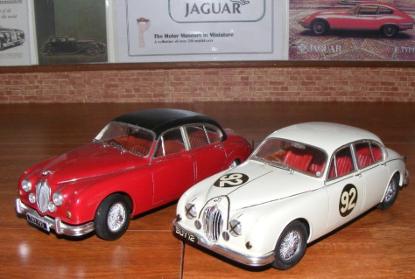
1959 Jaguar MK2.
1/24th scale Tamiya kit
Adhering to Sir William Lyons' maxim of "grace, pace and space", the mark2 was a beautiful, fast and capable saloon. It came with a 120bhp 2.4Ltr, 210bhp3.4Ltr or 220bhp 3.8Ltr Jaguar XK engine. The 3.8 is similar to the unit used in the 3.8 "E"-type (or XKE in the U.S.A.), having the same block, crank, connecting rods and pistons but different inlet manifold and carburetion (two SUs versus three on the "E" type in Europe) and therefore 30bhp less.
The Mark2 was discontinued in September 1967 and replaced by the 240 and 340, so named to distinguish them from the old 2.4 and 3.4 which became known as the Mark1 following the introduction of the Mark2 in 1959.
1960 Austin Se7en "Team Speedwell" Mini.
1/24th scale Tamiya kit
The Mini, probably the best-known car in the world, was launched in 1959 as the Austin Se7en and Morris Mini-Minor. The Austin label denoted the most basic and cheapest model (harking back to the days of the old Austin Seven model ethos) with Morris models being a little more sophisticated. Wolseley (Hornet) and Riley (Elf) versions would be added to the range to take the car more up-market, then the Cooper models made gave the speed edge that propelled Minis onto the race tracks and rally stages of Europe, and later, the world.
John Sprinzel's Speedwell Performance Conversion firm made upgrades for many cars in the BMC range and raced the cars too. When Sprinzel was joined by Graham Hill the firm got even more coverage and for a while Speedwell were arguably the top tuning firm in Britain.
1960 Sunbeam Rapier.
1/32nd scale Airfix kit
Rootes, having already revived Humber, Hillman and Commer, stepped in to salvage Sunbeam in 1935. The Sunbeam name was coupled with Talbot - now also Rootes owned - to offer a series of up-market and sporting versions of Hillmans and Humbers made at Talbots London Factory from 1938.
The Sunbeam Rapier, based on the Hillman Minx, continued into the late 1960’s, offering improved performance and specification. It was later replaced with a fastback version.
The Sunbeam name was all but dead by 1968 but has been occasionally revived by its subsequent owner Peugeot in a small way, such as the Sunbeam Lotus, based on the Talbot Horizon.
1960 Lotus Super seven series 2.
1/24th scale Tamiya kit
The 1960 Lotus Seven S2 was followed by the Lotus Super Seven in form. The Super Seven had a larger 1340cc Cosworth modified Ford Consul engine which gave the car even better performance. The new wings and options of having these in the bare Aluminium metal made these cars very popular not only for performance but for their looks too.
Around 1310 of this model were built between June 1960 and August 1968 in Lotus facilities before they moved onto the series three model. In time the Lotus seven would become one of the world's favourite sports cars, made under licence in many countries.
Lotus sold the rights to Caterham in August 1973 and many companies copied the basic design to release similar cars and many sources for Lotus Seven inspired cars remain available to this day.
More than 1.6 million Morris Minors, in all its variants, were produced in a production run of over two decades between 1948 and 1971. The Morris Minor proved to be an attractive model for all manner of commercial work. Vans and pickups were used by traders and the large companies like the Royal Mail Post office and GPO telecommunications. Many police forces also used the Minor 1000 as a general purpose and patrol car.
This number plate and appearance is from a “Panda” car that was used by the Wolverhampton Borough Police force in Wolverhampton (then still in Staffordshire), England, but the plate is actually a 1964 reg’. Some poetic licence is thus applied for the sake of making an interesting model and showing the potential of the kit.
1961 Triumph TR4.
1/32nd scale Revell Kit
The established TR sports car line received a fillip in 1961 with the arrival of the Michelotti-styled TR4 roadster, although the mechanicals were essentially carried over from its TR3 predecessor.
The TR4 was, in essence, a re-bodied TR3A/B with the added refinement of rack-and-pinion steering. It was also available with a “Surrey” hardtop, which, in concept, anticipated the Porsche Targa top by two years. A great improvement on what had gone before, it was, if anything, let down by its rigid suspension, the engineering of which was rooted in the previous decade. This was rectified to a great extent, by the TR4A of 1965 with trailing arm rear suspension.
1961 Jaguar "E" type.
1/32nd scale Airfix kit
Jaguars proud boast was that they provided ‘ grace and pace’.
In 1961 they backed up that boast with the perfect combination of looks and performance. At the beginning of the 60’s Jaguar needed a quantum leap as the XK series, which had itself caused such a sensation in 1948, was fast approaching senility. Improvements such as disc brakes and a styling facelift had helped, but there was no disguising its great age.
Enter, the "E" type Jag' and the world went mad for it.
1961 Jaguar "E" type coupe.
1/24th scale Monogram kit
March 16th 1961 is one of the most famous dates in Jaguar Chronology. It was then that the 31st Geneva Motor Show opened its doors to the public and there could be no doubt that the star of the event was Jaguars new 150 mph E-type sports car which was unveiled - in Coupe form.
1962 MG 1100.
1/32nd scale Airfix kit
Today the vast majority of the world’s saloon cars are driven by their front wheels from engines that are transversely located across the car, thus providing the maximum amount of space for the occupants. It has not always been so. For the first 80 or so years of the passenger car's history, most were pushed along by their rear wheels driven from front-mounted, in-line engines.
The vehicle that brought about the design revolution is Alec Issigonis’s Mini, introduced by the British Motor Corporation in 1959. Next step after the mini, code ADO15 was the ADO16, generally known as the ‘1100’.
In 1962 the Morris Minor ‘A’ series engine was increased to 1098cc (48 bhp) and became the power unit for the 1100 series cars. Badge engineering saw the introduction of Austin, Morris, Wolseley and Riley versions of the ‘1100’ And of course the MG 1100.
1962 JCB 3 backhoe.
1/76th scale Dapol kit
Universally known as JCB, J.C. Bamford Excavators Limited is a success story built on hard work and innovation. Joseph Cyril Bamford rented a lock-up garage and purchased a second-hand welding set for £1 from English Electric in October 1945 and set to work building a tipping trailer from war-surplus air raid shelters.
In 1961 the new JCB 3 series set new standards for the market and over the years was constantly updated to include revolutionary ideas and systems. It featured the pioneering JCB Hydraslide system that allowed the operator to position the backhoe anywhere across the chassis so as to get up to walls and allow him a clear view along the trench he was excavating.
1962 Ford Zodiac MkIII.
1/32nd scale Airfix kit
British Fords have often become iconic and our next car still lives in the memories of many who grew up in early 1960s Great Britain.
The Zephyr and Zephyr-Zodiacs were built in the UK from 1950 to 1976 in three series. From 1962 the Mk III versions were offered in both four- and six-cylinder versions. The Zephyr-Zodiac was the top of the range featuring a more luxurious interior with better rear visibility, a full width grill sporting 4 headlights and more powerful 6cyl. engine.
They were Ford UK's largest passenger cars until they were replaced by the even larger Consuls and Granada’s in 1971. The Zephyr was popular with many people due to its regular appearance in a popular TV program "Z Cars".
1963 Ford Cortina Lotus Mk1
The Cortina is regarded as a copybook exercise in engineering and, above all, product planning. Lotus input in the Cortina was expensive making the UK price £1100 yet the original contract of 1000 examples were sold out in no time; and the project tie up was so successful it continued into the MKII Cortina as well.
1963 Lotus 25.
1/20th scale Tamiya kit
The Lotus 25 re-wrote the design books when it debuted in 1962. But it had people talking for more than just its design and looks!
After much debate with Frank Costin and research in endless aeronautical journals Colin Chapman used aircraft technology to come up with the stressed skin monocoque chassis, providing lightweight with exceptional rigidity.
Now thought of as an iconic car the Lotus 25 was revolutionary at the time, although actually it wasn’t that revolutionary really...... It wasn’t the first monocoque chassis by a long way, that distinction going to the 1923 Voisin, nor was it the first British car with monocoque chassis as both the Jaguar D-type and E-type had monocoque central sections.
But, Chapman's genius lay in taking ideas from other areas and making them unbeatable in a racing car. The 25 was the first F1 monocoque chassis, and it took the F1 drivers championship for Jim Clark in 1963.
1965 Lotus Elan series 3.
1/24th scale Gunze Sangyo kit
The Lotus Type 26 design “Elan” was the replacement for the pretty, but unreliable and expensive to produce, Elite. Series 1 Elan production ran from 1962 to 1964 when the evolutionary series 2 Elan or type 36 design started production.
The car had a revolutionary steel backbone chassis with a sexy glass-fibre roadster body mounted on it. full independent suspension by twin A-arms with coil springs and dampers at the front and the famous Chapman Strut at the rear the Elan set new standards for handling with a comfortable soft ride.
1966 Vauxhall Viva HA.
1/32nd scale Airfix kit
Vauxhall's first post-war small car, the HA Viva saloon, was introduced in late 1963, with roomy passenger and luggage accommodation and a lively OHV 1057 cc engine developing 44bhp. A Bedford Beagle estate car version was available from late 1964.
The HA Viva was re-placed by the re-styled HB Viva.
1966 Sunbeam Tiger.
1/32nd scale Revell kit conversion
Rootes salvaged Sunbeam in 1935. Sunbeam was at the time coupled Talbot and went on to offer a series of up-market and sporting versions of Hillmans and Humbers made at Talbots London Factory from 1938.
The Hillman Minx based Sunbeam Rapier of the 1960’s, was accompanied by the two-seater Alpine which in turn had a high performance big brother, the Tiger.
The Sunbeam Alpine was an unlikely basis for a super car, and even the addition of a Ford V8 to form the Sunbeam Tiger couldn’t give it the normal attributes of a high-performance sports car, but it had a distinctive character.
The Sunbeam Alpine, on which the Tiger was so heavily based, was designed in the 1950’s with the idea of giving the Rootes Group a sports convertible-cum-GT Hard Top to rival the MGA and the Triumph TR Series. In engineering terms, it was little more than a combination of ‘off the shelf’ Rootes Group components - floor pan from the Hillman Husky Estate, engine and drive-train from the Hillman Minx series, clothed within an all-new sports style body.
The Alpine was launched in 1959 and progressed through a series of evolutions to become the Alpine MkV before production ceased at the beginning of 1968. In other words, although the Alpine was in production long before the Tiger and formed the basis for it, it also lingered in production after it. The Tiger was discontinued when Chrysler took over the Rootes Group - Well, they couldn’t have a Ford engined Chrysler could they?
1967 Mini Cooper Monte Carlo Rally.
1/24th scale Tamiya kit
After Pat Moss’ gave the Mini it's first Monte Carlo win in the Coupe des Dames in 1962 more competition success at the Monte Carlo followed in 1964,1965 and in 1966 (although the disqualification fracas took the victory away officially).
In 1967 Rauno Aaltonen and Henry Liddon gave hte Mini Cooper another victory but not without incident and a story that remained secret for over 20 years.
Built and donated by Mr. Roy Poulter
1967 Vauxhall FD2000 "Victor" estate.
1/32nd scale Airfix kit
Introduced in 1967 with choice of 1599 or 1975 cc 5-bearing engine units which had the block canted at 45 degrees to the left, allowing a lower bonnet line giving rise to the "slant-4".nomenclature.
The design was entirely British in concept but had clear American influences. The most significant aspects were the inbuilt safety features, a collapsible steering column, flush door handles, crumple zones and shatterproof rear view mirror to name a few. The Victor FD was awarded the Don Safety Trophy in 1968, a clear indication the car was leading the field in safety.
1967 MG B.
1/24th scale Aoshima kit.
All the MGB’s were driven by a 1798cc 4-cyl’ engine which hid behind an upright grill, most evidently different to that of the sloping grill on the ‘A’, allowing space for a bigger radiator and larger engines if needed later. The B series engine had been stretched, by boring out to 80.26mm x 88.9mm, to it’s limits but with all sorts of technical changes, including raising the compression ratio to 8.8:1, it was now giving 95bhp @ 5400rpm with 110 Ib/ft of torque @ 3000rpm.
1967 Lotus-Ford Cortina.
1/24th scale Scalekraft transkit on Esci base kit
1/32nd scale Airfix kit
The idea for the Cortina was spawned in September 1962. The Board of Directors wanted a car to compete with the family sized models from Morris (Oxfords) and Vauxhall (Victors). It was originally to be called the Ford Consul 325 but that catchy mouthful was dropped in favour of "Cortina", the Italian ski resort Cortina d’Ampezzo providing an air of excitement and modernity.
At Lotus the Cortina undertook radical changes to make the car more powerful, stable and ready for racing; and Lotus had their own catchy name for the new car, the Lotus 28.
Lotus got the Cortinas from Ford in kit form. They had to put all the panels together themselves, replacing opening panels with light alloy versions. This system also allowed them to amend items as required in their quest to upgrade handling, as well as the engine power output. Colin Chapman was allowed to undertake more than just an engine transplant. The transmission & four-speed gearbox, comprised of components modified by Chapman. Much of the suspension was changed, particularly at the rear, and alloy castings helped lighten many areas of the car.
1967 Jaguar 420.
1/32nd scale Airfix Kit
Jaguar’s large saloon line was up-dated in 1961 with the arrival of the Mk X. Excessively wide and thirsty, it was not perhaps the happiest of car designs but, like its smaller Mk II stablemate, it did get better as it got older.
This subsequently evolved into the 420 of 1967, so called because of its 4.2 litre engine.
1968 Lotus 49b "World championship winner".
1/24th scale Heller kit
Once again Colin Chapman studied and idea and evolved it into a world beating racing car. This time it was the concept of using the engine as a stressed part of the chassis. The idea really belonged to the semi stressed Lancia D50 engine of 1954 but in conjunction with Keith Duckworth and Mike Costin the Ford backed DFV engine became an integral part of the chassis.
Almost exclusively developed by Graham Hill it is perhaps a little unfair that the debut win for the Lotus 49 fell to Jim Clark at Zandvort in 1967. But in the most strenuous of situations it was Hill that reaped the drivers title in 1968 with the Lotus 49b.
1968 MG B.
1/32nd scale Revell kit.
The MGB was, in truth, more of a high-speed tourer than a sports car. Two people could be accommodated in comfort and there was room for two small children on a ledge behind the seats, the generous internal dimensions were a product of the unitary body and chassis structure. In the end the MGB was shorter than the ‘A’ but had more passenger compartment, and luggage, space.
1968 Lotus 56 Indy Turbine car.
1/25th scale MPC kit.
Colin Chapman noted the progress of the Paxton turbine in the 1967 Indy 500 and started thinking about the possibilities not only for Indy racing but for F1 too.
He came up with ideas for an entirely new and more advanced design, using a Pratt and Witney turbine engine and a revolutionary aerodynamic shape. For all Chapman's ideas it was Maurice Philippe who actually designed the Lotus 56 for the 1968 Indianapolis 500 and the concept performed much better than expected; until the driveshafts broke!
Model built and donated by Mr. John Lewis.
1969 Lola T70 Mk3b.
1/24th scale Roaring Replicars kit
The Lola concern has made cars for almost every form of motorsports but it has had the most success in the world of sports car racing. Introduced in 1965 the T70 was similar to the GT40 (but without a roof), because the GT40 owed much of it’s design to Broadley’s 1962 LOLA MK6 GT sports coupe. Careful ‘weight engineering' meant that the T70 spyder was lighter that the Ford GT40 and, when mated to the Traco Engineering built 5.9-litre V8 Chevrolet engine, and Hewland’s brand new LG 500 gearbox, it was faster than any contemporary F1 car.
1969 Riley Elf.
1/24th scale Scale kraft body on Tamiya base kit
Billed as a more luxurious version of the Mini, the Riley Elf saw the designers return to the more traditional three box saloon style. A modified Mini body-shell incorporated each marque's distinctive traditional upright grille design, both very different from the Minis, in an elongated nose. The rear was also considerably different to the Mini, lengthened to create a larger boot framed by longer, slightly finned rear wings. The external changes didn’t stop there. More external chrome brightened up the exterior on larger diameter hub caps and bumpers with over-riders.
1969 Austin Maxi.
1/32nd scale Airfix kit
Launched to a fanfare of publicity on the 24th of April, 1969, in Oporto, Portugal, the Maxi was the first car launched by the new British Leyland Motor Corporation. Prior to the launch of the Maxi the board at BL were quite bullish about the new cars’ prospects.
The Maxi never sold in the numbers it was expected to. Poor quality control and a higher price than much of the competition of the time restrained the Maxi’s sales considerably. The last Maxi, a Champagne coloured ‘L’ model registered as ‘LOV 476X’ in July 1981, is now on display at the Heritage Motor Centre in Gaydon.
1970 Issigonis' 9X Mini.
1/24th scale Fujimi/Tamiya kit conversion.
Sir Alec Issigonis’ design team at the Longbridge works developed numerous variations on the Mini under the code-named, 9X. Pet projects included in the programme were a highly efficient ‘DX’ engine design, an innovative gearless transmission system, using a torque converter, and even a steam powered engine for the Mini.
The 9X, under the design number ADO20, was completely new. Built to Issigonis most stringent set of goals; nothing in the prototype cars was an off the shelf item from the parts warehouse. It was bold, it was radical, it was incredible.
1970 MG B GT.
1/43rd scale K&R Replicas kit.
While the MGB was to be one of the longest model runs in MG History the MGB-GT is to the version that captures the imagination.
The ground-breaking ‘greenhouse’ design of this sporty "hatchback" was produced by Pininfarina. It combined the sporty feel of the MGB, with the utility of an estate car and the flexibility of the 2+2 passenger layout. No wonder it is revered by it's fans.
1970 Morgan 4/4.
1/24th scale Tamiya kit
The Morgan 4/4 was such a perfect balance of sportiness, looks, price and reliability that, with numerous improvements and developments over the years, it became the backbone of Morgan model range in continuous production from 1936 to the present day; apart from the years of World War two of course (during which time Morgan made parts for anti-aircraft guns and aero-engines).
1971 Tyrrell 003.
1/25th scale Doyusha kit
The new 001 chassis of 1970 was quick, but initially unreliable, this was developed to become the 002 and 003 chassis for 1971 which were basically the same design but with differing wheelbases and other minor differences.
In the hands of Stewart and François Cevert, the team took eight wins during 1971 and 1972.
1973 Lotus Elan sprint.
1/24th scale Gunze Sangyo kit
Roy Poulter
1973 Ford Capri 2000 GT.
1/24th scale Doyusha kit
"The car you always promised yourself" – well that’s what Ford said when they introduced the Capri, the European version of the Mustang, Ford’s run-away success in America.
This was the Grand Tourer for everyman. The Capri was remarkably enduring being built by Ford in Britain and in Germany (from 1976 on in Germany only). When production ceased in 1987 1.8 million had been built.
1974 Surtees TS16/03.
1/32nd scale Matchbox kit
The TS16 was a development of the promising TS14, but it was overweight and with little funding the teams DFV engines were a little less than top notch and there was little chance of development work.
Pace's fourth place at his home track in Mexico were the only points Surtees got all year, with drivers struggling to qualify; and if they did, retirement would be the likely outcome.
1975 Leyland Princess.
1/43rd scale Heller kit
The wedge shaped Princess saloons had an initial choice of engines between the 1798cc B-series or 2227cc E-series units. From July 1978 the OHC O-series engines were fitted, in 1695cc or 1993cc forms.
The Princess was developed into the Ambassador range from March 1982, the top-of-the-range model being the Vanden Plas.
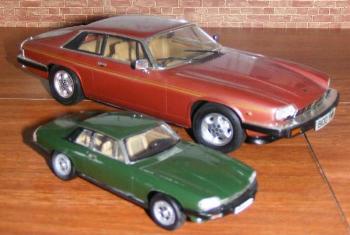
1975 Jaguar XJ-'S’.
1/24th scale Hasegawa kit
1/43rd scale Airfix kit
A replacement for the E-Type but not its successor, the XJ-S coupe has developed into a remarkably enduring and distinctive grand tourer. It was not, initially, the most endearing of Jaguar models.
The 150 mph car was launched in 1975 in the middle of the energy crisis. Then just as the XJ-S seemed to be becoming established, along came an even more damaging petrol price hike. Little wonder that the car virtually ceased production in 1980/81.
Just before the model was written of the new High-Efficiency engine went into production and a revised XJ-S HE model went on sale from July 1981. The line eventually ended in 1996 when the third model went out of production.
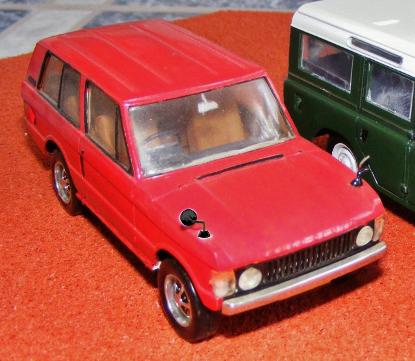
1975 Range Rover.
1/43rd scale Heller kit
The Range Rover is a tremendous trendsetter unique in motoring. The all wheel drive mud-plugger manufacturer glamorised off-road, all terrain vehicles and turned them into fashion accessories for the beautiful people keen for a taste of the country.
Exuding virtues of solid construction (Steel chassis and alloy body work), more than sufficient V-8 derived power, a high-rise driving position and excellent road manners, the Range Rover became the only vehicle in which to be seen in fashionable South London’s Chelsea.
The Range Rover is one of the finest bespoke off-road vehicle money can buy, highly regarded throughout the world.
1976 Triumph TR7.
1/24th scale Airfix kit
The TR7 Coupe of 1975 was a completely new design and reverted to the four-cylinder theme of previous TR series cars. Intended as British Leyland’s corporate sports car, the wedge shaped styling proved controversial, and it was plagued with production and reliability problems. It was dropped in 1981, despite 112,368 having been built; a record for the TR range.
In 1980 came the TR8, with Rover’s proven 3.5 litre V8 engine. This was, perhaps, what the TR7 should have been in the first place.
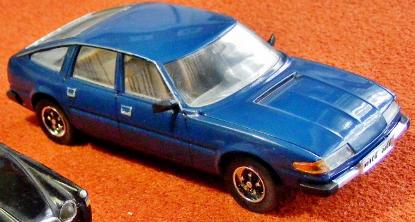
1976 Rover (Leyland) 3500.
1/43rd scale Heller kit
1976 Tyrrell P34 F1.
1/20th scale Tamiya kit
In 1976, the Tyrrell team again went into secret mode and came up with the Project 34.
Arguably one of the two most radical entries ever to succeed in F1. It had four small front wheels, reportedly to reduce frontal area, but these were followed by the standard huge rear wheels on a wider track.
If the idea of the smaller front tyres was to increase air penetration, reducing 'frontal area' reduces drag, they also increase the contact area between the tyre and the track leading to better mechanical grip for cornering. The answer applied to the P34 giving it four 10-inch front wheels. This required a complex suspension design so all the front wheels could be steered.
The design had an unforeseen safety advantage too, when a car came into the pits with the driver complaining of understeer it was found to have a puncture! This hadn’t stopped him lapping at racing speeds either.
1977 Lotus 78 F1
1/20th scale Tamiya kit.
The Lotus 78 and 79 were the result of Colin Chapman taking a fresh approach to the problem of creating a winning formula 1 car. From that original clean sheet of paper, Chapman came up with a 17-page document outlining just what he wanted for his new concept, the ‘wing car’. From that point on, design and development work was largely delegated.
Chapman’s genius had been shown in coming up with the idea; the other engineers on his staff turned the concept into reality. It was not the first time that Chapman and Lotus had achieved a break through, (the monocoque Lotus 25 of 1962 was one, as was the Lotus 49) but this innovation was the greatest of them all.
The Transit was a modern marvel, a huge step forward from the Ford Thames van it replaced and the Commer and Bedford CA vans it was competing against. It’s flexibility, comfort and ease of use were such a revelation the Transit was an immediate success and soon a familiar sight on British roads and became a byword for all light commercial vans.
Today there is hardly a company in Britain that hasn’t used a Transit based vehicle. A cargo van in short and long wheel base, a minibus, cutaway van chassis, a drop-side pickup truck, recovery vehicles, food vendors, the list of Transit chassis applications is huge making it a bedrock of local commerce and allowing Ford to Market the van as “the backbone of Britain”.
1980 Mini City.
1/24th scale Fujimi kit
Few cars remain in production for over 40 years but the Mini was one of them. It evolved, like the Beetle and 2CV, and through the 1980s the Mini City range was one of British Leyland’s efforts to keep sales coming in during a very difficult time; to which eventually succumbed.
However, the Mini, which had been born in the BMC era would out-last BL and remain on sale until Rover finally stopped production in 2000.
The earliest of the Mini City series went on sale in 1979 as the 850 City and 850 Deluxe models. Today these cars are very rare, desirable and expensive as in 1980 the 850cc engines were dropped, replaced by the 998cc unit.
1980 Ford Escort XR3.
1/24th scale Airfix kit
The front wheel drive Escort was the first Ford car distributed world wide under the same model description.
Production of the MKIII body style commenced in July 1980. Ford invested some 2 million DM in this project. The outstanding styling feature of this model was the notchback shape.
The 1.6 litre engine allowed the sporty XR3 to accelerate to 60 mph in 9.7 seconds. Maximum speed was 115 mph.
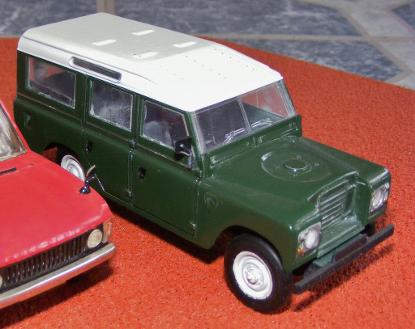
1982 Land Rover series 3 lwb.
1/43rd scale Airfix kit
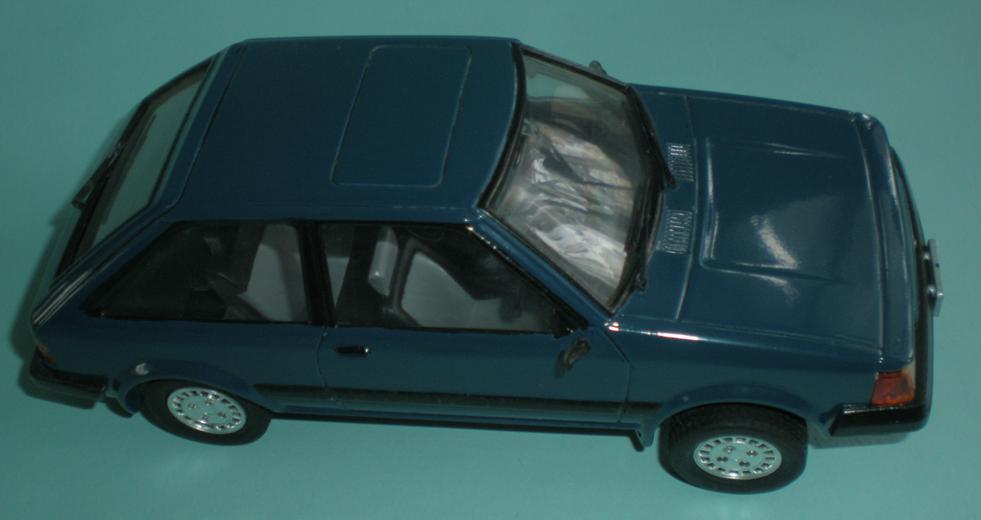
1983 Ford Fiesta.
1/24th scale Mitsuwa kit
The MKII Fiesta appeared late in 1983. Externally it was not much more than a mild facelift of the MKI, having a smoother front end more like the Sierra, but the interior was all-new.Available with the options of petrol or diesel engines, manual or automatic gearboxes and a very sporty XR2 package, with the 1.6ltr engine previously used on the XR3 Escort models. The Fiesta was a best seller in the UK and also popular in Europe until the end of the 1980’s when it could no longer compete with the more modern Peugeot 205, especially in the hot hatch market.
1987 Lotus Esprit SE.
1/25th scale Monogram kit
Lotus achieved miracles with their Esprit, transforming it from its humble 160 bhp origins of more than a decade before, to a 264 bhp turbo intercooled supercar - the SE, capable of over 160 mph
The Esprit was designed by Giogetto Giugiaro and the prototype shown at the Turin Show in 1972. Initially the design did not meet with Colin Chapman’s approval, but he was soon won over. It was designed to take Lotus from the sports car bracket into the supercar league and did that with progressive updates: the original 2-litre car had only 160 bhp, but power output rose progressively over the years. The series 2 car was still a 2-litre, but the 2.2 Turbo Esprit of 1980 took power up to 215 bhp. That in turn was boosted even further by the more efficient intercooler SE, with a massive 264 bhp.
There has been one really major change in appearance over the years, when Giugiaro’s original sharp- edged design was softened to a more rounded shape in 1988.
Today Lotus is part of the General Motors empire and many people still think the nearest thing to a true supercar Britain ever built, was the Esprit Turbo SE.
1987 Jaguar XJR-8 le Mans.
1/24th scale Hasegawa kit
1988 and Jaguar once again win the Le Mans 24 Hour Race after an interval of 31 years. It was a statement to the world that, after a traumatic decade, the company was once again a force to be reckoned with on both road and track.
Completed in 1985, teams ran in 1986 and 1987 with the XJR-8 although in both years the Jaguars proved to be no match for the Porsche opposition. However, in 1987, the XJR-8 gave Jaguar its first ever world sports car championship victory.
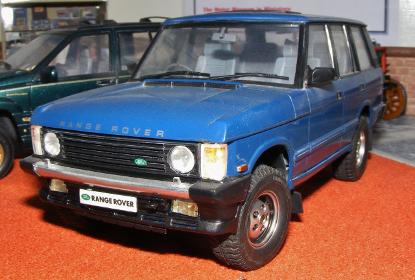
1987 Range Rover.
1/24th scale Aoshima kit
1988 Jaguar XJR-9 IMSA.
1/24th scale Hasegawa kit
Jaguar had been out of racing for some time when the idea of supporting a new racing programme was floated. The American team Group 44 Racing were supported with V12 engines for the Fabcar-built XJR-5 in the IMSA series. Once that side of the Atlantic was covered Jaguar linked up with long term Jaguar touring car customer team, Tom Walkinshaw Racing (TWR), to develop another car, the XJR-6 for the World Sportscar Championship, (primarily a European series) using the same Jaguar V12 engine. Jaguar gained reputation while others stood the major cost!
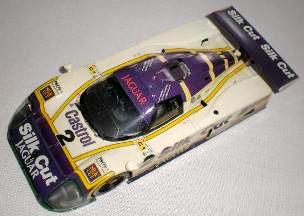
1988 Jaguar XJR-9 Le Mans.
1/24th scale Hasegawa kit
In 1988, no less than five XJR-9s were entered for the Le Mans; one was victorious and another came in fourth. It was the first Jaguar Le Mans triumph since 1957.
A further victory followed in 1990 with XJR-12’s in first and second places, to bring to seven Jaguars triumphs in the 24 Hour classic race.
1992 Williams FW14b.
1/24th scale Hasegawa kit
After an encouraging season in 1991, and reliability becoming almost assured for 1992, it became a record breaking season for Team, car and driver.
Patrick Head oversaw the development of the FW14b which now had had some body work revisions, as Adrian Newey improved on his own aero package, a computer controlled fully active ride system, with no springs or dampers, and Nigel Mansell.
Mansell was able to bully the absolute maximum out of the car, whether by bravery or brute strength is often debated, but, at some circuits, he was almost two seconds faster than his team mate, Ricardo Patrese, who was himself often a second ahead of the rest of the field!
1992 Jaguar XJ220.
1/25th scale Revell kit
1/24th scale Tamiya kit
First presented at the 1988 motor show, at the NEC in England, it was the work of an unofficial group of Jaguars staff who got together outside of work time to come up with new ideas. Originally conceived as having a V12 engine, 4WD, antilock braking and potentially traction control and active suspension. Even four wheel steering was considered.
1997 Jordan 197.
1/24th scale Revell kit
Jordan's 197 car was Designed by Gary Anderson who had been with Jordan F1 since their 1991 debut season. Peugeot's A14 72-degree V10 engine was mated to Jordan s own seven-speed longitudinal semi-automatic gearbox.
The car really stood out with its distinctive bright yellow livery and title sponsorship from Benson & Hedges. The cars also had a snake painted on the nose with a forked tongue that extended back around the sides of the driver's cockpit,
2001 BMW MINI ONE
It is never easy to replace an iconic car like the Mini, even Issigonis himself struggled to come up with something better that British Leyland would consider producing. The closest thing that appeared was the Mini Metro, quickly rebranded simply as the Austin Metro, but an actual Mini type replacement was an on/off idea reviewed intermittently and basically shelved for lack of funds to develop it.
British Leyland became “the Rover Group” and the Mini replacement, ever more urgently needed, remained under deliberation. Finally, in 1993, Rover decided the time had come to do something serious. The following year BMW acquired the Rover group and both Rover and BMW had their own ideas about what a new Mini ought to be; the ideas were not at all alike.
2007 Jaguar XK.
1/87th scale 4D kit
Jaguar, from its earliest days as “Swallow Sidecars”, has created many great, and stylish, sports cars. The leaping cat has also seen great triumphs and depression ridden eras too. The new XK range launched in 1996 embodied everything the company stood for with a sleek three-door hatchback coupé and a refined convertible.
While some described the 2007 XK as looking like an XK8 that been to the gym, the truth was this was no evolution of the previous car but significantly different car. On the outside it may have had similarly gracefully sloping lines and still exhibit the renowned Jaguar craftsmanship and quality but now it had cutting edge technology in design, construction and onboard computational aids.
2007 Aston Martin DBS.
1/24th scale Tamiya kit
Roy Poulter
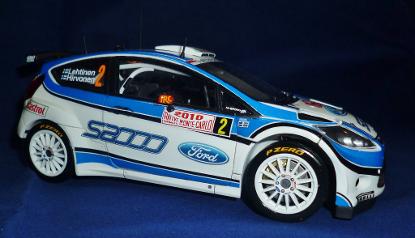
2010 Ford Fiesta S2000.
1/24th scale Belkits kit
The Super 2000 challenge series in Rallying and touring cars was part of the FIA's push to reduce the costs of motor sport. Ford/M-sport's Fiesta S2000 went from the drawing board to running in a rally stage in just nine months and not only suited the then current S2000 and IRC regulations but was expected to form the basis of Ford's WRC challenge in the coming years, which it did.
The Fiesta S2000's competition debut was at the 2010 Monte-Carlo Rally in January of that year, and it led from start to finish. M-Sport went on to deliver 22 Ford Fiesta S2000 rally cars to customers as far flung as Finland, the Czech Republic, Ireland, Spain, South Africa, Poland, Portugal, Abu Dhabi and Italy.
This Page is under construction as there are many British models to add. We are sorry for any disappointment caused but ask you to keep visiting as the collection is sure to keep expanding. Thank you.
